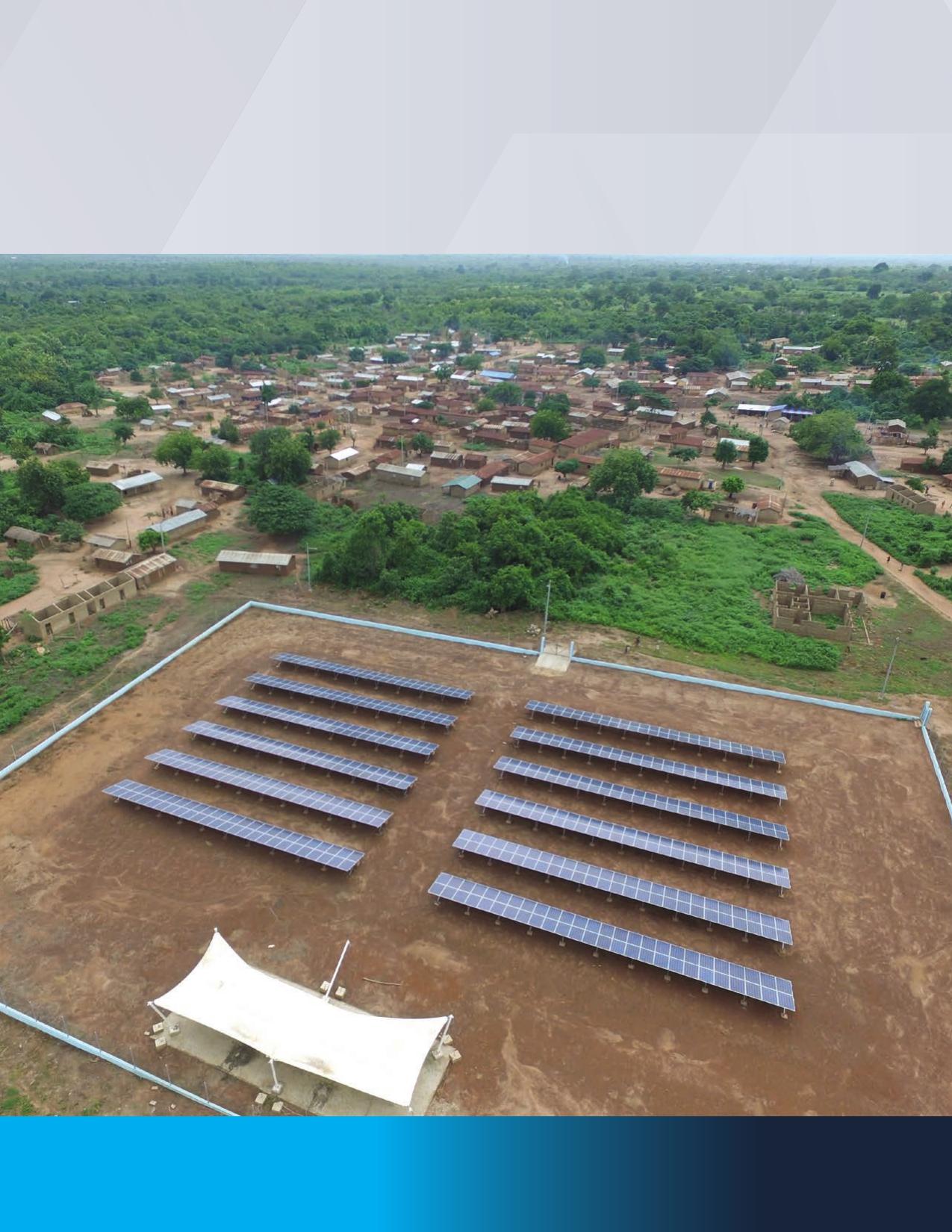EnergyStorageforMiniGridsStatusandProjectionsofBatteryDeploymentAnEnergyStoragePartnershipReportEnergyStorageforMiniGridsStatusandProjectionsofBatteryDeploymentThisreportoftheEnergyStoragePartnershipispreparedbytheEnergySectorManagementAssistanceProgram(ESMAP)withcontributionsfromtheAllianceforRuralElectrification(ARE),RicereasulSistemaEnergetico(RSE),LoughboroughUniversity,andtheInter-AmericanDevelopmentBank(IADB).TheEnergyStoragePartnershipisaglobalpartnershipconvenedbytheWorldBankGroupthroughESMAPEnergyStorageProgramtofosterinternationalcooperationtodevelopsustainableenergystoragesolutionsfordevelopingcountries.Formoreinformationvisit:https://www.esmap.org/the_energy_storage_partnership_espiiENERGYSTORAGEFORMINIGRIDS:STATUSANDPROJECTIONSOFBATTERYDEPLOYMENTABOUTESMAPTheEnergySectorManagementAssistanceProgram(ESMAP)isapartnershipbetweentheWorldBankand24partnerstohelplow-andmiddle-incomecountriesreducepovertyandboostgrowththroughsustainableenergysolutions.ESMAP’sanalyticalandadvisoryservicesarefullyintegratedwithintheWorldBank’scountryfinancingandpolicydialogueintheenergysector.ThroughtheWorldBankGroup(WBG),ESMAPworkstoacceleratetheenergytransitionrequiredtoachieveSustainableDevelopmentGoal7(SDG7)toensureaccesstoaffordable,reliable,sustainable,andmodernenergyforall.IthelpstoshapeWBGstrategiesandprogramstoachievetheWBGClimateChangeActionPlantargets.Learnmoreat:https://esmap.org©2023InternationalBankforReconstructionandDevelopment/TheWorldBank1818HStreetNW,Washington,DC20433Telephone:202-473-1000;Internet:www.worldbank.orgRightsandPermissionsThematerialinthisworkissubjecttocopyright.BecausetheWorldBankencouragesdisseminationofitsknowledge,thisworkmaybereproduced,inwholeorinpart,fornoncommercialpurposesiffullattributiontothisworkisgiven.Anyqueriesonrightsandlicenses,includingsubsidiaryrights,shouldbeaddressedtoWorldBankPublications,WorldBankGroup,1818HStreetNW,Washington,DC20433,USA;fax:+1-202-522-2625;e-mail:pubrights@worldbank.org.Furthermore,theESMAPProgramManagerwouldappreciatereceivingacopyofthepublicationthatusesthispublicationforitssourcesentincareoftheaddressabove,ortoesmap@worldbank.org.ThisworkisavailableundertheCreativeCommonsAttribution3.0IGOlicense(CCBY3.0IGO)http://creativecommons.org/licenses/by/3.0/igo.UndertheCreativeCommonsAttributionlicense,youarefreetocopy,distribute,transmit,andadaptthiswork,includingforcommercialpurposes,underthefollowingconditions:Attribution—EnergySectorManagementAssistanceProgram(ESMAP).2023.EnergyStorageforMiniGrids:StatusandProjectionsofBatteryDeployment.Washington,DC:WorldBank.Translations—ThistranslationwasnotcreatedbyTheWorldBankandshouldnotbeconsideredanofficialWorldBanktranslation.TheWorldBankshallnotbeliableforanycontentorerrorinthistranslation.Adaptations—ThisisanadaptationofanoriginalworkbyTheWorldBank.Viewsandopinionsexpressedintheadaptationarethesoleresponsibilityoftheauthor(s)oftheadaptationandarenotendorsedbyTheWorldBank.Third-PartyContent—TheWorldBankdoesnotnecessarilyowneachcomponentofthecontentcontainedwithintheworkanddoesnotwarrantthattheuseofanythird-partyownedindividualcomponentorpartcontainedintheworkwillnotinfringeontherightsofthosethirdparties.Ifyouwishtoreuseacomponentofthework,itisyourresponsibilitytodeterminewhetherpermissionisneededforthatreuseandtoobtainpermissionfromthecopyrightowner.Examplesofcomponentscaninclude,butarenotlimitedto,tables,figures,orimages.ProductionCreditsProductionEditorHeatherAustinDesignerCircleGraphics,Inc.FrontCover©IRENABackCover©IRENAAllimagesremainthesolepropertyoftheirsourceandmaynotbeusedforanypurposewithoutwrittenpermissionfromthesource.TABLEOFCONTENTSABBREVIATIONS...................................................................................................................VIIACKNOWLEDGMENTS........................................................................................................VIIIKEYFINDINGS.......................................................................................................................IXEXECUTIVESUMMARY.........................................................................................................X1BATTERYTECHNOLOGIESINMINIGRIDSACROSSTHEWORLD..........................11.1TheGlobalStockofMiniGrids...............................................................................21.2TheGenerationMixofMiniGrids..........................................................................31.3TheRoleofStorage...............................................................................................31.4�TheRoleoftheLevelizedCostofStorageintheTechnologySelectionProcess..................................................................................................51.5UsingMiniGridsforProductiveUses:BeyondBasicAccesstoElectricity...........51.6ChallengesFacedbyMiniGridDevelopers...........................................................52�SIZEOFTHEGLOBALMARKETFORMINIGRIDANDENERGYSTORAGE............72.1NumberofPeoplewithoutAccesstoElectricity.....................................................72.2ProjectedAccessby2030.....................................................................................82.3RuralMiniGridInstallationsin2021......................................................................82.4ForecastingGlobalDemandforMiniGridsandBatteryStorageSystems...........93SELECTIONOFBATTERYTECHNOLOGY...................................................................123.1FactorsInvestorsConsider..................................................................................123.2ComparisonofStorageTechnologies..................................................................143.3TheCapitalCostofBatteries...............................................................................153.4TheLevelizedCostofStorage.............................................................................164FUTURETRENDSINBATTERYSTORAGEFORMINIGRIDAPPLICATION...........204.1UsedLithium-IonBatteriesasaStationaryStorageSolution..............................204.2Iron-AirBatteriesforLong-TermEnergyStorage................................................214.3SodiumIonBatteries............................................................................................224.4Hydrogen-PoweredStorage................................................................................224.5FlywheelEnergyStorageforMiniGridStabilization...........................................225CASESTUDIES...............................................................................................................245.1�SolarMiniGridswithLeadAcidBatteries:TheHuskPowerMicrogridsInitiativeinIndiaandNigeria................................................................................245.2�SolarHybridMiniGridwithLithiumIronPhosphateBatteries:TheLolweIslands,Uganda...................................................................................................25ivENERGYSTORAGEFORMINIGRIDS:STATUSANDPROJECTIONSOFBATTERYDEPLOYMENT5.3�SolarHybridMiniGridwithLithium-IonNickelManganeseCobaltBatteries:SanSeth,Bogale,Myanmar................................................................................265.4�SolarHybridMiniGridwithLithiumIronPhosphateBatteries:Dancitagi,Nigeria..................................................................................................................265.5�SolarMiniGridwithLithiumIronPhosphateBatteries:Makhala,Amperehour,India................................................................................................275.6�SolarMiniGridwithVanadiumRedoxFlowBattery:Maldives............................285.7�SolarMiniGridwithFlywheelEnergyStorageSystems:ThePhilippines...........286RECOMMENDATIONS....................................................................................................31REFERENCES..................................................................................................................33APPENDIXA:TYPESOFENERGYSTORAGE..............................................................35APPENDIXB:I�MPROVINGTHEPERFORMANCEOFLEADACIDBATTERYSTORAGEMINIGRIDS............................................................................38LISTOFFIGURESANDTABLES�vLISTOFFIGURESANDTABLESFIGURES1.1NumberofInstalledandPlannedMiniGrids,byRegion,2021..................................21.2NumberofInstalledandPlannedMiniGridsinSelectedCountries,2022................21.3GenerationMixofInstalledandPlannedMiniGrids,2019........................................31.4BatteryStorageTransitioninRuralMiniGridsinAsiaandAfrica,2012–21..............31.5PrimarySourceofBatteryStoragebySelectedMiniGridDevelopersin2017–21........41.6MiniGridBatteryStorageasPercentageofTotalCapacity,byTechnologyType,2012–21............................................................................................................41.7SharesofLeadAcidandLithium-IonasSourcesofBatteryStoragebyMiniGridsinSouthandSoutheastAsiaandAfrica,2022.........................................41.8EffectofGridLoadFactoronLevelizedCostofElectricity........................................52.1NumberofPeopleWithoutAccesstoElectricity,byRegion,2021and2030............82.2ProjectedAnnualIncreaseinNumberofRuralPeoplewithAccesstoElectricity,byRegion,2021–30..................................................................................82.3DistributionofMiniGridCapacity,byRegion,2021...................................................92.4ProjectedAnnualGlobalDemandforRuralMiniGridintheLow-,Base-,andHigh-CaseScenarios,2021–30........................................................................102.5ProjectedGlobalCumulativeCapacityAdditionofNewRuralMiniGrids,2022–30....................................................................................................................102.6ProjectedGlobalDemandforBatteriesforRuralMiniGrids,2021–30....................113.1EstimatedandProjectedDemandforBatteriesforMiniGrids,byType,2021–30....................................................................................................................133.2CostofSix-HourStorage,byBatteryType,2022–30..............................................153.3LevelizedCostofStorageofSelectedBatteryTypesatDifferentDurations...........183.4ContributionsofCapitalExpense,OperationsandMaintenance,ResidualValue,andElectricityCosttotheLevelizedCostofStorage,byBatteryType........183.5EstimatedandProjectedLevelizedCostofStorageforSix-HourDurationSystem,byBatteryType...........................................................................................194.1ProjectedChangesinBatteryPerformanceBetween2018and2025,byTypeofBattery.....................................................................................................215.1HuskMiniGridintheVillageofAkura,inNasawaraState,Nigeria.........................255.2HybridSolarMiniGridintheLolweIslands,Uganda...............................................25viENERGYSTORAGEFORMINIGRIDS:STATUSANDPROJECTIONSOFBATTERYDEPLOYMENT5.3IceManufacturingUnitPoweredbyEngie-Equatorial’sSolarMiniGridintheLolweIslands,Uganda.............................................................................................265.4HybridSolarMiniGridinSanSeth,Bogale,Myanmar............................................275.5SolarHybridMiniGridwithContainerizedEnergyStorageSolutionsInstalledbyPowerGeninDancitagi,Nigeria...........................................................................275.6SolarMiniGridwithContainerizedBatteryEnergyStorageSysteminMakhala,India..........................................................................................................285.7VanadiumRedoxFlowBatteryEnergyStorageSystemattheMalahiniKudaBandosResort,Maldives..........................................................................................295.8KineticEnergyStorageSystemsinthePalawanislands,thePhilippines................30TABLES2.1EstimatedandProjectedMiniGridCapacityperHousehold,byRegion,2021and2030............................................................................................................92.2BatteryCapacityinSelectedMiniGridProjectsInstalledin2020–21.....................112.3RatioofBatteryCapacitytoMiniGridInstalledCapacity........................................113.1TechnicalParametersofSelectedBatteryTechnologies.........................................143.2PughMatrixRankingofStorageTechnologiesinMiniGridApplications................153.3DescriptionsandAssumedValuesinLevelizedCostofBatteryStorageCalculations..............................................................................................................17ABBREVIATIONSCAPEXcapitalexpenditureCSRCorporateSocialResponsibilityDERdistributedenergyresourceEEEngie-EquatorialESPEnergyStoragePartnershipESSenergystoragesystem(s)FESSflywheelenergystoragesystem(s)GWhgigawatthour(s)kgkilogramkVAkilovoltamperekWkilowattkWhkilowatthour(s)kWpkilowattpeakLCOElevelizedcostofelectricityLCOSlevelizedcostofstorageLFPlithiumferro-phosphateMWhmegawatt(s)NMCnickelmanganesecobaltO&MoperationsandmaintenancePALECOPalawanElectricCooperativePVphotovoltaicSIPCORS.I.PowerCorporationVRFBvanadiumredoxflowbatteryWwattWhwatthourWpwattpeakAllcurrencyisinUnitedStatesdollars(US$,USD),unlessotherwiseindicated.viiACKNOWLEDGMENTST�hisreportwaspreparedbytheWorldBank’sEnergySectorManagementAssistanceProgram(ESMAP)andCustomizedEnergySolutions,andundertheauspicesoftheWorkingGroupFiveoftheEnergyStoragePartnershipwithtechnicalcontributionsandreviewsbyJonExel(SeniorEnergySpecialist,WB),ChrisGreacen(Consultant,WB),andAlfredoVillavicencio(Consultant,WB).GabrielaElizondoAzuela(PracticeManager),ChandraGovindarajalu(LeadEnergySpecialist),JulietPumpuni(SeniorEnergySpecialist,WB),andClemenciaTorresdeMästle(SeniorEnergySpecialist,WB)providedinvaluablecontributionsandoverallguidance.SpecialthankstoHuskPowerSystems,EngieEnergyAccess,PowerGen,Amperehour,andAmberKineticsforprovidinginformationforthecasestudies;andtothefollowingEnergyStoragePartnershippartners–JensJaeger(ARE),LucianoMartini(RSE),EdBrown(LoughboroughUniversity),andEdwinMalagon(IADB)whoparticipatedinthepeerreviewprocess.KEYFINDINGST�hisreportspecificallyfocusesonbatteryenergystorageindecentralizedoff-gridminigridslocatedinremoteareas.Itprovidesanoverviewofbatterytechnologiesusedinminigridsglobally,demandforecastsforvariousbatterytechnologies,acomparisonofcharacteristicsofdifferentbatteries,anexplorationofcostsandtrendsinbatterytechnologies,casestudies,andrecommendations.Inthehigh-casescenario,itisprojectedthatannualdemandforminigridbatteriesisprojectedtoincreasetoover3,600MWhby2030fromaround180MWhin2020.Inabase-casescenario,annualdemandexceeds2,200MWh,whileinthelowcaseannualdemandisaround1,500MWh.Theselectionofbatterytechnologyformini-gridprojectsisamulti-faceteddecisionbasedonfactorssuchascyclelife,depthofdischarge,typeofloadconnectedtothegrid,energydensity,C-rating,thermalrunaway,maintenance,after-salesservice,hardwarecompatibility,maturity,cost,batterydegradation,operatingconditions,andenvironmentalconcerns.Thelevelizedcostofstorage(LCOS)iscriticalforoptimaldecision-makinginminigriddevelopment.Thoughupfrontcostsoftendominatethetechnologyselectionprocess,theLCOSprovidesamorecomprehensiveperspectivebyconsideringthelifetimecostofstoragetechnologies.TheLCOScalculationincorporatesthecapitalexpenditure,operationsandmaintenancecosts,residualvalue,andcostofchargingthebattery.Whileleadacidbatteriescostlesspernameplatecapacity($/kWh),thesuperiorcyclelife,efficiency,andpermissibleroutinedepthofdischargeoflithium-ionbatteriesresultinalowerLCOS.Lithium-ionbatterieshavegrowninpopularityandaredisplacingleadacidbatteries,thankstoreducedprices,longerlifespan,andminimalmaintenancerequirements.Historically,leadacidbatterieswerethego-tochoiceduetotheirmaturity,availability,andlowupfrontcost.Lithium-ionpricesareforecastedtodeclineuntil2030.Incontrast,leadacid,amaturetechnology,maynotwitnesssignificantpricedrops.Forecastssuggestthatlithium-ionbatterieswillextendtheirleadasthelowest-costbatterytechnologyforminigridsdroppingfrom2022LCOSof$0.37perkWhto$0.34in2026and$0.32by2030,notwithstandingthelikelihoodthatrawmaterialcostsforlithium-ionbatteriesriseduetodemandfromtheelectricvehicleindustry.Thecostofleadacidbatterieswilldeclineonlyslightly,from$0.55to$0.54perkWhoverthistimeperiod.Inthenearfuture,otherbatterystorageoptionsarepromising,including“second-life”lithium-ionbatteries,sodium-ionbatteries,iron-airbatteries,hydrogen,andflywheelenergystorageThisreportincludescasestudiesofminigridsfromAfricaandAsiathathighlightglobaldeploymentofbatterytechnologiesrangingfromconventionalleadacidtolithium-ion,toVRBFandflywheelstorage.Eachcasestudydescribestheminigrid’srating,energystoragerating,batterychemistry,businessesserved,communitieselectrified,andthewayinwhichtheelectricityisused.Minigridenergystoragerecommendationsinclude:studyingbatteryperformanceinactualoperatingconditions,consideringtotalcostandnotjustupfrontbatterycost,adoptingsafetyandperformancestandards,promotingrecyclingpractices,encouragingtheuseofrepurposedbatterytechnologies,exemptingminigridbatteriesfromimportduties,providingtechnicalskillstraining,andcreatingstandardoperatingprocedurestounderstandbatterytechnologyperformance.ixEXECUTIVESUMMARYTheEnergyStoragePartnership(ESP),establishedbytheWorldBankin2019,aimstodevelopandimplementenergystoragesolutionsfordevelopingcountries.Thesesolutions,coupledwithrenewableenergysources,couldprovideelectricitytoover1billionpeoplewhocurrentlylackreliableaccess.Aminigridisaninterconnectedsystemofdistributedenergyresources(DERs)–generallyincludingrenewableenergyandelectricitystorage—thatoperatesindependently,servicingcustomergroupsofvarioussizes,fromremoteareastourbanlocations.Theseminigridssupportarangeoffacilitiesincludingprimaryhealthcenters,agriculturalactivities,learningcenters,hospitals,airports,andcommercialestablishments.Thisreportspecificallyfocusesonbatteryenergystorageindecentralizedoff-gridminigridslocatedinremoteareas.Itprovidesanoverviewofbatterytechnologiesusedinminigridsglobally,demandforecastsforvariousbatterytechnologies,acomparisonofcharacteristicsofdifferentbatteries,anexplorationofcostsandtrendsinbatterytechnologies,casestudies,andrecommen-dations.Italsoincludesappendicesthatofferabroadoverviewofmechanical,electrochemical,andthermalstorage,aswellasperformanceoptimizationofleadacidbatteriesinminigrids.Globalelectricityneeds,particularlyinremoteandruralareas,areasignificantchallenge.Asof2020,anestimated740millionpeoplestilllackaccesstoelectricity,577millionofwhomliveinSub-SaharanAfrica(SSA).ThoughSSAhasanelectrificationrateof48%asof2020,ambitiousnationalelectrificationplansincountriessuchasEthiopia,Ghana,Kenya,Nigeria,Rwanda,andSenegalaimtoattainuniversalaccessby2030.Someofthese2030targetshavebeenimpactedbytheCOVID-19pandemic,withmanydevelopingcountrieslikelytoexperiencedelays.Undertheexistingtrajectory,itisexpectedthatabout800millionpeoplewillgainaccesstoelectricitybetween2021and2030,leaving560millionunelectrified.Toachievefullelectrificationby2030,itisnecessarytoprovideelectricitytoaround1.3billionpeople.Growingdeploymentofminigridsarereachingsomeofthisunelectrifiedpopulation,with21,000minigridscurrentlyservingabout48millionpeopleworldwide.Toservehalfabillionpeopleby2030,theworldneedsafleetof217,000minigrids,mostofwhichwillbepredominatelypoweredbysolarelectricitywithbatterybackup.SouthAsiapresentlyleadswiththehighestnumberofinstalled(9,600)andplanned(19,000)minigrids.Afghanistan,India,andMyanmarcompriseabout80%ofminigridsinthisregion.Africaisestimatedtohaveabout3,100installedminigridswithabout9,000inthepipeline.InAfrica,Nigeria,Tanzania,Senegal,andEthiopiaareamonganumberofcountriesthathaveembarkedonambitiousprojectstoboosttheirnationalelectrificationratesusingminigrids.InitiativessuchastheNigerianElectrificationProjectandtheRuralElectrificationAgencyofSenegalintendtoprovidepoweraccesstooveramillionhouseholdsandenterprisesusingminigrids.Theparadigmisshiftingfromtraditionaldieselandhydro-basedgridstothird-generationminigridspoweredbysolarandhybridenergysystemsandemployingadvancedtechnologieslikeprepaidmetersandonlinemonitoring.Thedecliningcostofsolarpanels,coupledwiththeabundantavailabilityofsunshineindevelopingcountries,ismakingsolar-poweredminigridsaneconomicallyfeasibleandenvironmentallyconsciouschoice.In2021,approximately1,100ruralminigridprojectswereinstalledglobally,providing80MWofcapacity.SouthAsialedinannualinstallations,followedbySub-SaharanAfricaandSoutheastAsia.Projectionsforglobaldemandforminigridsbetween2022and2030,alongsidetheneedforbatterystoragesystemstosupporttheseminigrids,havebeenformulatedunderthreescenarios—highcase,basecase,andlowcase.Inthehigh-casescenario,itisprojectedthatannualdemandforminigridbatteriesisprojectedtoincreasetoover3,600MWhby2030fromaround180MWhin2020.Inabase-casescenario,executivesummary�xiannualdemandexceeds2,200MWh,whileinthelowcaseannualdemandisaround1,500MWh.Lithium-ionbatteries,inparticular,haveseenincreasedusageinminigrids,especiallyinSub-SaharanAfrica.By2030,lithium-ionbatterypenetrationisprojectedtoriseto70percentfrom55percentin2021(FigureES.1).Expandingtheroleofminigridsforproductiveuses,beyondbasicelectricityaccess,allowsforincreasedgridutilizationwithoutacorrespondingriseinpeakload.Theoutcomeislowerlevelizedcostsofelectricity(LCOE)andexpeditedreturnoninvestmentfordevelopers.CasestudiesfromBangladeshandIndiavalidatetheeffectivenessofthisapproach.Despitetheirimmensepotential,minigridsfacevariouschallenges,includingremoteprojectlocations,difficultiesinmonitoringandmaintenance,sustainabilityconcerns,taxationissues,riskofstrandedassets,lackoffinancing,andanabsenceofstandardization.Operationalchallengesrelatedtotemperaturealsopresentdifficulties,particularlyforstoragetechnologies.Overcomingthesebarrierswillbevitaltoleveragethefullpotentialofminigridsinmeetingtheworld’senergyaccessgoals.Storagetechnologiesarecentraltotheefficiencyandreliabilityofminigrids.Theselectionofbatterytechnologyformini-gridprojectsisamulti-faceteddecisionthatinvestorsbaseonfactorssuchascyclelife,depthofdischarge,typeofloadconnectedtothegrid,energydensity,C-rating,thermalrunaway,maintenance,after-salesservice,hardwarecompatibility,maturity,cost,batterydegradation,operatingconditions,andenvironmentalconcerns(TableES.1).Historically,leadacidbatterieswerethego-tochoiceduetotheirmaturity,availability,andlowupfrontcost.Basedonadatabaseof170minigridsusing30MWhofcombinedstorage,lithium-ionbatterieshavegrowninpopularityandaredisplacingleadacidbatteries,thankstoreducedprices,longerlifespan,andminimalmaintenancerequirements.AqualitativePughmatrixassessmentwithresponsesfromminigriddevelopersrevealslithium-ionasthemostsuitabletechnology,despiteredoxflowbatteriesscoringhighonbatterylifeandenvironmentalfriendliness.VanadiumRedoxFlowBatteries(VRFBs)alsoshowpromiseduetotheirlongoperationallife,highdepthofdischarge,robustperformanceacrossarangeoftemperatures,andpotentialforcostreductionthroughinnovativebusinessmodelssuchasvanadiumleasing.Whenconsideringthecapitalcostofbatteries,leadacid,amaturetechnology,maynotwitnesssignificantpricedrops.Incontrast,lithium-ionpricesareforecastedtodeclineuntil2030,notwithstandingthelikelihoodthatrawmaterialcostsforlithium-ionbatteriesriseduetodemandfromtheelectricvehicleindustry.Consideringthelevelizedcostofstorage(LCOS)iscriticalforoptimaldecision-makinginminigriddevelopment.Thoughupfrontcostsoftendominatethetechnologyselectionprocess,theLCOSprovidesamorecomprehensiveperspectivebyconsideringthelifetimecostofstoragetechnologies.TheLCOScalculationincorporatesthecapitalexpenditure,operationsandmaintenancecosts,residualvalue,andcostofchargingthebattery.Whileleadacidbatteriescostlesspernameplatecapacity($/kWh),thesuperiorcyclelife,efficiency,andpermissibleroutinedepthofdischargeoflithium-ionbatteriesresultinalowerLCOS.ForVRFBs,theCAPEXperkWhsignificantlydropsasstoragedurationincreases.Forecastssuggestthatlithium-ionbatterieswillextendtheirleadasthelowest-costbatterytechnologyforminigridsdroppingfrom2022LCOSof$0.37perkWhto$0.34in2026and$0.32by2030,whilethecostofleadacidbatterieswilldeclineonlyslightly,from$0.55to$0.54perkWhoverthistimeperiod.VRFBsareexpectedtobecomeincreasinglycompetitivewithleadacidbatteries(FigureES.2).FIGUREES.1:ProjectedGlobalDemandforBatteriesforRuralMiniGrids,2021–304,0003,500Capacity(MWh)3,0002,5002,0001,5001,00050002021202220232024202520262027202820292030LowCaseBaseCaseHighCaseSource:CES.xiiENERGYSTORAGEFORMINIGRIDS:STATUSANDPROJECTIONSOFBATTERYDEPLOYMENTTABLEES.1:TechnicalParametersofSelectedBatteryTechnologiesBatteryTypeParameterLeadAcidAdvancedLithium-IonNiNaCl2VanadiumZn–Br(flowtech)LeadAcidNickel,sodiumRedoxBatteriesBatterychemistryLeadLead,carbonNMC/LFPchlorideelectrodes70–90(VRB)Round-tripefficiency(percent)60–8080–9085–95C/6-C/8C-rateC/10C/5C/4-2C80VanadiumZinc,bromineDepthofdischarge(percent)50–6070–809065–70Energydensity(Wh/kg)40–6027–3080–1504,500–5,00060–7068–70Cyclelife500–1,0001,200–1,8002,000–6,000MediumC/5-C/8C/3–C/4SafetyHighHighMedium750–1,000100100CAPEX($/kWh)80–150120–300250–350Medium7–815–25ToxicityofchemicalsHighHighHigh270–3507,000–10,0003,000–3,500Operatingtemperature(°C)–20–50–20–500–555HighMediumSelf-discharge(percent/month)10–153–50.5–2600–1000750–800Source:CES.MediumHigh15–5520–50560FIGUREES.2:EstimatedandProjectedLevelizedCostofStorageforSix-HourDurationSystem,byBatteryType0.60.50.4LCOS($/kWh)0.30.20.10.0202220262030LeadAcid0.550.540.54Adv.LeadAcid0.520.500.49Li-ionLFP0.370.340.32VanadiumRedox0.430.410.40NiNaCl20.550.510.48Source:CES.executivesummary�xiiiInthenearfuture,otherbatterystorageoptionsarepromising.“Second-life”lithium-ionbatteriespresentsapotentialstationarystoragesolutionaftertheyhavebeencycledoutofuseinautomotiveapplicationsandthoroughlytested.Sodium-ionbatterieshaveemergedasapotentialsolutionforenergystorageinsolarmini-grids,withadvantagesoverlithium-ionbatteriesintermsofrawmaterialabundance,reasonablecyclelife,comparableenergystoragecapacity,adaptablemanufacturingprocesses,andimprovedsafetyandstability.Iron-airbatteriesmightofferaviablepathforlow-costlong-termenergystorage,despitetheirlowerenergydensity.Hydrogen-poweredstoragesolutions,capableofstoringenergyforlongerperiodsthanbatteries,arebeingproposedasalternativestotraditionaldieselgeneratorsandcouldpotentiallypowerminigridsinremoteareas.Flywheelenergystorage,whichstoreskineticenergyinarotatingmass,offerssignificantadvantages,suchasalonglifetime,increasedcharge-cyclecapabilities,andrapidoutput,whilelackinghazardouschemicalsorfirehazards.Itscurrentconstraintsincludecost,rapidself-discharge,andlimitedcapacityforextensiveenergystorage.Casestudieshighlightglobaldeploymentofemergingstoragetechnologies.Eachcasestudydescribestheminigrid’srating,energystoragerating,batterychemistry,businessesserved,communitieselectrified,andthewayinwhichtheelectricityisused.HuskPowerSystemsinIndiaandNigeriauseshybridsystemscombiningsolarPV,batteries,andbiomassgasificationtopowerover200communitysolarminigrids.Theirsystememploysmachinelearningtooptimizethebatterymanagementandincreasethelifetimeofitslead-acidbatteries.Thecompany’scarefulapproachtomonitoringandcontrollingleadacidcharge-dischargecyclesanditsabilitytoobtainattractivevolumepricingonIndian-madeleadacidbatteriesaretworeasonsitusesleadacidbatteries.IntheLolweIslands,Uganda,EngieEnergyAccessandEquatorialPowerdeployedahybridsolarminigridwithLithiumIronPhosphate(LFP)batterystorage.Theminigrid,supplyingover3,800consumers,issupplementedwithabusinessincubationandassetfinancingprogramthatincludeswaterpurification,icemaking,electricmobility,andagro-processing.Theseactivitieslimitthedependenceondieselgeneratorsandhelpthedevelopersutilizetheminigridsattheirfullcapacity.InSanSeth,Bogale,Myanmar,MandalayYomadevelopedahybridsolarminigridwithlithium-ionnickelmanganesecobalt(NMC)batteries.A713Wphybridsolarminigridwithstoragecapacityof1,312kWhoflithium-ionnickelmanganesecobalt(NMC)batteriesispairedwitha315kVAgenset.Thegrid,suppliesover1,300householdsand20businesses.TheselectionofNMCbatterytechnologyisprimarilyduetoitslifespanofover3,000cycles.InNigeria,morethan250minigridsarecurrently.PowerGenminigridatDancitagivillageusesa200kWpsolarhybridminigridwith500kWhoflithiumironphosphatebatteriesanda200kVAdieselgensetat.Thisgridhasbroughtsignificantimprovementsinpowersupply,andtwoyearsafterinstallation,theloadonthesitehadincreased,andtherewasademandforadditionalstoragecapacity.InIndia,AmperehourandtheMaharashtraEnergyAgencyDevelopmentAuthority(MEDA)haveestablishedsolarminigridsatMakhala,Amravati,andMaharashtra.Theseminigridsrelyon110kWhofcontainerizedlithiumironphosphate(LFP)batteries,providingconnectionstoover127customers.Nodieselgeneratorsareused.Amachinelearning-basedalgorithmcontroloptimizestheloadprofileandinformsdecisionmakingInMaldives,theKoreancompanyH2builtasystemcombiningsolarpowerandavanadiumredoxflowbattery(VRFB).Thissystemwasdesignedtoproduce1MWhperdayandstoreelectricityforuseduringpeakhoursorwhensolarpowerisunavailable.ThesystemwasspecificallyengineeredtowithstandthechallengingmaritimeconditionsintheMaldives.InthePhilippines,thePalawanElectricCooperative(PALECO)andS.I.PowerCorporation(SIPCOR)areimplementingamicrogridprojectusingsolarPV,dieselgenerators,andflywheelenergystoragesystems(FESS)fromAmberKinetics.Thissystemprovidesenergytotheinhabitants,reducingtheirrelianceontheunreliablegridandpromotingeconomicgrowth.Itisalsoenvironmentallyfriendlyasitreducescarbonemissionsandtheisland’sdependenceondieselfuelforpowergeneration.Recommendationsforimprovingtheimplementationandsuccessofdecentralizedrenewableenergyminigrids,withafocusonenergystoragetechnologies:1.Studybatteryperformanceinthefield:Conductcomprehensiveanalysesofdifferentbatterytechnologiesunderactualconditionswhereminigridsarebuiltandoperate.2.Considertotalcost:Whenplanningminigrids,considertheLevelizedCostofStorage(LCOS)andhowthebatteriesaffecttheLevelizedCostofEnergy(LCOE),notjusttheupfrontcostofbatteries.xivENERGYSTORAGEFORMINIGRIDS:STATUSANDPROJECTIONSOFBATTERYDEPLOYMENT3.Adoptsafetyandperformancestandards:Thesestandardswillreducerisksandincreaseindustryacceptance,particularlyiftheyalignwithstandardsdevelopedbyinternationalorganizations.4.Carefullydraftregulatorydocumentsandprocurementspecifications:Thisensuressafety,quality,andperformancewithoutrestrictinginnovationinstoragetechnologies.5.Promotebestrecyclingpractices:Astheindustryshiftstowardlithium-iontechnologies,it’scrucialtodevelopandimplementstrategiesforrecyclingthesebatteries.6.Encouragetheuseofrepurposedbatterytechnologies:Developastandardfortestingandcertifyingsecond-lifebatterypackstoincreaseconfidenceintheiruseforminigrids.7.Exemptminigridbatteriesfromimportduties:Tomakebatterytechnologymoreaffordableandexpeditetheirdeploymentinminigrids.8.Provideskillingandupskillingprograms:Thesewillenhancetechnicalcompetency,reducedowntimeofminigridsystems,andcreateemploymentopportunitiesincommunities.9.Createstandardoperatingproceduresforunderstandingbatterytechnologyperformance:Thiswillhelpminigridplayersoptimizetheirassetutilizationandreducerisks,forexample,byunderstandingtheeffectsofenvironmentalconditionsonbatteryperformance.1BATTERYTECHNOLOGIESINMINIGRIDSACROSSTHEWORLDIn2019,theWorldBankconvenedtheEnergyStoragePartnership(ESP),aglobalpartnershiptoadapt,develop,androlloutenergystoragesolutionsfordevelopingcountries.Storagetechnologies,intandemwithrenewableenergysources,havegreatpotentialtoprovideaccesstoelectricitytothemorethan1billionpeoplewhoeitherlackaccessorareservedpoorly.Toenabletherapiduptakeofvariablerenewableenergysourcesindevelopingcountries,theESPisworkingondevelopingpowersystems,disseminatingknowledge,buildingcapacity,developingtestingprotocols,validatingperformance,providingflexiblesectorcoupling,developingdecentral-izedenergystoragesolutions,craftingprocurementframeworks,enablingenergystoragepolicy,andrecyclingsystemsandstandards.ThisreportisaknowledgeproductoftheprojectleadbyWorkingGroup5,whichfocusesondevelopingknowledgeproductstosupportthedevelopmentandexpansionofenergystoragesolutions.Aminigridisagroupofinterconnectedmultipleorsingledistributedenergyresources(DERs)andloadsthatworkindependentlyinremotelocationsorgridconnectedareas(SE4All2022).Minigridscatertocustomergroupsofdifferentsizes,rangingfromafewconsumersinremoteareastothousandsofconsumersinurbanareas.Inremoteareas,minigridshaveimprovedenergyaccesstoprimaryhealthcenters,lighting,agriculturalactivities,includingproductiveuseapplicationslikeagriculturalprocessingandcoldstorageandlearningcenters.Urbanminigridsservehospitals,airports,SpecialEconomicZones,universities,andsmallcommercialestablishments.Somesuccessfulminigridsarealreadyconnectedtothecentralgrid;othersmaybeconnectedinthefuture.Yetothersareinlocationsthataretooremotetobeconnectedintheforeseeablefuture.Thisreportfocusesondecentralizedoff-gridminigridsinremotelocations.Itisorganizedasfollows.•Section1providesanoverviewofbatterytechnologiesinminigridsacrosstheworld,usinginformationcollectedthroughinterviewswithmajorprojectdevelopersandplantoperators.•Section2forecastsdemandforvariousbatterytechnologiesdeployedortargeted.•Section3comparesvariousstoragetechnologiesforminigridapplications.•Section4explorescostsandtrendsinbatterytechnologiesdeployedinminigrids.•Section5presentssevencasestudies.•Section6proposesrecommendations.•AppendixAprovidesabroadoverviewofmechanical,electrochemical,andthermalstorage.•AppendixBdiscussesperformanceoptimizationofleadacidbatteriesinminigrids.OVERVIEWIn2020,around9.5percentoftheworld’spopulation(approximately740millionpeople)lackedaccesstoelectricity(WorldBank2020a).Around500millionofthemliveinSub-SaharanAfrica(WorldBank2019a).Thelackofaccesstoelectricitycanbeattributedtosparsepopulationdensities,theremotelocationsofthevillages,financiallystressedstate-ownedelectriccompanies,lowwillingnesstopay,andlackofcapitalinvestment.Asof2022,around21,500minigridsworldwidewereservingaround48millionpeople.Another29,400projects,withthecapabilitytoserveanother35millionpeople,wereinthepipeline.Thispipelinewillservelessthan5percentofthepopulationwithoutaccesstoelectricity.Toservehalf12ENERGYSTORAGEFORMINIGRIDS:STATUSANDPROJECTIONSOFBATTERYDEPLOYMENTFIGURE1.1:NumberofInstalledandPlannedMiniGrids,byRegion,202120,00019,000Numberofminigrids/off-grids15,0009,6009,0007,200connections10,000SouthAsia3,1005,0008001,200400300100AfricaOther0EastAsia&PacificOECD&CentralAsiaInstalledPlannedSource:ESMAP2022.abillionpeopleby2030,theworldneedsafleetofThenationalelectrificationrateinNigeriaisaround217,000minigridspoweredbysolarandhybridenergy55percent,witharuralelectrificationrateofonlysystems(ESMAP2022).39percent.Toachieveuniversalenergyaccessby2030,Nigerianeedstoconnect500,000to800,000households1.1�THEGLOBALSTOCKOFeveryyear,withafocusonruralareas.TheNigerianMINIGRIDSElectrificationProject(NEP),withsupportfromtheWorldBank,theAfricanDevelopmentBank,andotherSouthAsialeadstheworldintermsofboththenumberpartners,aimstoprovideenergyaccesstounder-andofminigridsinstalled(9,300)andplanned(19,000)unservedcommunitiesinNigeriausingrenewableFigure1.1showstheregionaldistribution.energy.Theprojectpromoteselectricityaccessforhouseholds;micro,small,andmedium-sizeenterprisesTogether,Afghanistan,India,andMyanmarhave(MSMEs);andpubliceducationinstitutions.Itaimstoabout80percentoftheworld’sinstalledminigridsinprovidecost-effectivepowerto250,000MSMEsandAsia.Afghanistanhasthelargestnumberofminigrids1millionhouseholdsthroughoff-gridandminigridinstalled(around4,700).By2018,Indiahadbroughtsystemsby2023.Theplanwillinstallminigridsystemselectricalpolesandwirestoallofitssettlements.Itnowin250sitesandtarget15minigridsatfederaluniversitiesaimstoincreasethereliabilityandproductiveuseof(Nweke-Eze2022).power.Achievingtheseobjectivesrequiresalargefleetofsolar-poweredminigrids.InSenegal,theRuralElectrificationAgencyofSenegal(ACER)aimstoinstall1,000minigrids,inordertoachieveFIGURE1.2:NumberofInstalledandPlannedMiniGridsinSelectedCountries,2022A.Numberofinstalledminigrids20,00018,900B.Numberofplannedminigrids5,0004,7004,0004,00015,0003,0003,20010,000India2,0001,5001,200NepalChina1,0005,0002,7001,5001,200600-NigeriaEthiopia-AfghanistanMyanmarIndiaTanzaniaSenegalSource:ESMAP2022.BATTERYTECHNOLOGIESINMINIGRIDSACROSSTHEWORLD�3FIGURE1.3:GenerationMixofInstalledandPlannedasbackupgenerators,deployedduringextendedcloudyMiniGrids,2019periods.100%Theincreasedpopularityofsolar/solarhybridminigridsreflectsthreemainfactors:1918•Sunshineisabundantlyavailable.Percentofgeneration80%5•Mostdevelopingcountriesunderstudydependon60%40importsforthesupplyoffossilfuels.40%78•Capitalexpenditure(CAPEX)perkilowatt(kW)isprojectedtofallfrom$3,659in2021tounder20%35$2,500by2030(ESMAP2022).Thisdeclinehasthepotentialtomakeeachunitofelectricitygenerated0%7bythesegridscompetitivewithelectricitysuppliedbythemain/centralgridinmanyareas.InstalledminigridsPlannedminigridsDieselOther1.3THEROLEOFSTORAGESolar&solarhybridHydroNewerminigridsgenerallypairrenewableswithbatteriesSource:AnalysisbyCES.supplyingfourtosixhoursofelectricityintheeveningandmorninghours,whensolargenerationisloworunavailable.a2025targetofuniversalaccesstoelectricityby2025Tolearnabouttheuseofbatterytechnologyinminigrid(Burger2022).applications,CESintervieweddevelopersrepresenting382minigridsand72megawatthours(MWh)of1.2�THEGENERATIONMIXOFbatterystorageusage.1In2017–21,202oftheseminiMINIGRIDSgrids,with39MWhofstoragewerebuiltby8minigriddevelopers(figure1.4).Tenminigrids—with3MWhofManyminigridsareeitherfirst-orsecond-generationgridsflowbatteryandsodium-basedbatteryenergystorageusingdieselorhydroasthemainsourcesofgeneratingtechnologycomprisedofflowbattery(manufacturedbyelectricity.Mostoftheprojectsinthepipelinearethird-VFLOWtechnologies)andsodium-basedtechnologiesgenerationgrids.Thesegridsgenerallyusesolarorsolar/(Dielectrik)—werealsoadded(figures1.5and1.6).dieselhybridstogenerateelectricity;theyuseadvancedtechnologieslikeremotemonitoringandsmartpre-paidAdatabaseof170minigrids,with30MWhofmeterstoensuretheseamlessfunctioningofminigrids.storage,wasdevelopedbasedonsecondarysources.Third-generationminigridsinstalledbymembersoftheOver80percentofthesampledminigridswereoperatingAfricanMiniGridDevelopersAssociation(AMDA)reportinAsia.TherestwereoperatinginAfrica.averageuptimesof99percent(AMDA2022).Withthedeclineinthecostofsolarpanels,dieselgeneratorsnolongermakefinancialsenseastheprimarysourceofelectricityinminigrids.TheyarenowusedFIGURE1.4:BatteryStorageTransitioninRuralMiniGridsinAsiaandAfrica,2012–2110,000Batterystorage(kWh)8,0006,0004,0002,000020122013201420152016201720182019202020215,5203,3606,8408,4001,0001,4003,6004,4003,2002,800Li-ionBattery5,4006,2004,7605,0403,3603,600LeadAcidBatteryLeadAcidBatteryLi-ionBatterySource:CES.4ENERGYSTORAGEFORMINIGRIDS:STATUSANDPROJECTIONSOFBATTERYDEPLOYMENTFIGURE1.5:PrimarySourceofBatteryStoragebySelectedMiniGridDevelopersin2017–2110.09.08.02.20.67.7Batterystorage(MWh)7.0Mlinda0.56.01.41.55.04.03.06.64.94.21.81.82.01.40.41.01.51.71.1Selco0.0AmperehourEngieEnergyAtlantiaSchneiderEnergyGIZNigeriaMandalayAccessRenwiaAccessYomaNickel-SodiumChlorideLeadAcidLithiumLFPLithiumNMCSource:CES.Leadacidstoragetechnologywasthedominantlithium-iontechnology.Otherrespondentsbelievedthatchoiceforminigriddevelopersbefore2018.Sincethen,leadacidbatterytechnologyislikelytobeusedformanylithium-ionbatterieshavebeenincreasinglypopular,moreyears,althoughmostminigriddevelopersareslowlyreaching44percentofdeployedbatterystoragebeginningtouselithium-iontechnologyintheirenergytechnologiesin2021.Theirincreasedpopularityinstoragemix.theelectricvehiclesectorhasledtoreductionsinthepriceoflithium-ioncells.Lithium-ionbatterieshavebecomeBecauseofitsrobustperformanceinabroadrangemoreattractiveforminigriddevelopersbecauseofthisoftemperatures,redoxflowbatterytechnologycanbepricereductionandthebatteries’increasedavailability.agoodoptionforminigrids.Itisstillintheinitialphaseofdevelopment.SomedevelopersexpressedinterestinMandalayYoma—asolarenergyproviderinexperimentingwithflowbatteries.InvinityEnergy,VFlowMyanmar—usesonlylithium-ionbatterytechnologyTech,andDelectrikmanufactureredoxflowbatteriesfor(figure1.7),becauseofitsincreasedlifeandmaintenance-theminigridmarket.freeoperation.ItexpressedconfidenceinthefutureofOfthe37.4MWhofstoragedeployedinminigridsFIGURE1.6:MiniGridBatteryStorageasPercentageof(seefigure1.7),65percentofstoragecapacityisinTotalCapacity,byTechnologyType,2012–21SouthandSoutheastAsiaand35percentisinAfrica.2%2%FIGURE1.7:SharesofLeadAcidandLithium-IonasSourcesofBatteryStoragebyMiniGridsinSouthandSoutheastAsiaandAfrica,2022100%23%80%28.744.1Percentoftotal60%73%40%71.355.920%LeadAcidLi-ion0%South&SouthEastAsiaAfricaRedoxFlowNickelSodiumChlorideSource:CES.LeadAcidLithium-IonSource:CES.BATTERYTECHNOLOGIESINMINIGRIDSACROSSTHEWORLD�5(Redoxflowbatteriesandsodium-basedtechnologiesthenew-generationminigridsarepromotingproductive-wereexcludedfromtheanalysisinordertocompareuseapplications,suchaseggincubators,grindersleadacidandlithium-iontechnologiesdeployed.)forpulses,waterpumps,flourmills,andothersmallbusinessuses.1.4�THEROLEOFTHELEVELIZEDCOSTOFSTORAGEINTHEIncreaseduseofproductiveappliancescanincreaseTECHNOLOGYSELECTIONtheloadfactorofthegrid.DomesticloadpeaksduringPROCESSmorningsandevenings;thegridisrelativelyloadfreeinthemiddleoftheday.TheadditionofproductiveThelevelizedcostofstorage(LCOS)isafinancialtermappliancescreatesloadduringbusinesshours,leadingfortheaveragecostofstoringeachunitofenergyinatoincreasedutilizationwithoutanincreaseinpeakload.storageprojectoveritslifetime.IttakesintoconsiderationWhenelectricityusedtopowerproductiveappliancesisdifferentcostitemsandtheirtiming,thetimevalueoftheconsumedatthesametimetheelectricityisgenerated,money,andtheopportunitycostoftheinvestedcapital.thelevelizedcostofelectricity(LCOE)falls(figure1.8).Doublingtheloadfactorfrom20percentto40percentForminigriddevelopers,upfrontcost(CAPEX)ishasthepotentialtoreducetheLCOEby25percent.animportantfactordeterminingtheselectionofatech-Lowerlevelizedcostssupportsustainablebusinessmodelsnology,andcanovershadowotherkeyparameterssuchandhelpdevelopersachievetheirtargetsearlier.astheusefullifeoftheproject,efficiencyparameters,andthecostofoperationsandmaintenance(O&M).TheSuroBanglaminigridinBangladesh,developedIndeed,despitethelowerlifetimecostoflithium-ionbytheInfrastructureDevelopmentCompanyLimitedbatteries,leadacidtechnologyisstillusedbymany(IDCOL),generateditsfullpotentialwithin1.5years,ayeardevelopersbecauseofthelowupfrontcost.Usingtheearlierthaninitiallyprojected,thankstotheuseofproduc-LCOScanhelpdecisionmakersmakebetterchoicestiveloads(ESMAP2022).TheminigridinShivpura(Uttarabouttechnology.Pradesh,India)powersmanyproductiveloads,includingabank,asweetsshop,aschool,andothersmallbusinesses.1.5�USINGMINIGRIDSFORPRODUCTIVEUSES:BEYOND1.6�CHALLENGESFACEDBYBASICACCESSTOELECTRICITYMINIGRIDDEVELOPERSWithanaverageuptimeof99percent,third-generationMinigridsaroundtheworldfaceoperationalandfinan-minigridsprovidehighlyreliablesuppliesofelectricitycialchallenges,includingthefollowing:thatgobeyondbasicaccesstoelectricity.Mostof•Remotelocation:Hightransportcostsofequip-mentandrawmaterialsincreasethecostsofminigridesinremotelocations.Safetyrequirementsforbatterytransportationcanaddcosts.FIGURE1.8:EffectofGridLoadFactoronLevelizedCostofElectricity0.600.55LCOE($/kWh)0.500.450.400.350.300102030405060708090Gridloadfactor(percent)Source:ESMAP2019.6ENERGYSTORAGEFORMINIGRIDS:STATUSANDPROJECTIONSOFBATTERYDEPLOYMENT•Monitoring:Remotenessmakesitdifficulttosendearlyandreducethisrisk,developersoptforlowerpersonnelforperiodicmonitoring.Asmostminipaybackperiods.Lowerpaybackperiodsneedhighergridsarefarfromtelecommunicationnetworks,annualcapitaldepreciationandincreasethecostofmonitoringthroughtechnologicalinterventionslikeeachunitofelectricitygenerated.Thehighercostwirelesscommunicationdevicescanbedifficult.ofeachunitgeneratednegativelyaffectsusersandBatterytechnologiesthatrequireperiodicmonitoringhencethelarge-scaledeploymentofminigrids.presentchallenges.•Financing:Someminigridprojectshavebeen•Periodicmaintenance:Itisdifficulttofindcompe-fundedexclusivelybygrants.Theseprojectstenttechnicianstocarryoutperiodicmaintenancetendtobeunsustainable,comingtoahaltwheninremoteareas.Developerstrytobridgethegapfundingends.byidentifyinglocalentrepreneursandtrainingtheminmaintenance.•Absenceofstandardization:Thesizeofindividualequipmentlikeinverters,batteries,andswitchgear•Businesssustainability:Consumers’willingnesslackminigrid-specificstandardization.Asaresult,topayforelectricityisoftenlow.Someminigridsomecomponentsareover-designedandnotfullydevelopers/companieschargeasmuchasutilized.Thereisnostandardminigridsizethatgrid$0.75/kWh—farmorethantheaveragecostdeveloperscanusefordeployment.AstandardsizeofelectricityofferedbysomeutilitiesinAfricancouldbebasedonthesizeofthecommunitytobecountries.Storagechoicesrequirebalancingcostservedortheavailableload.againstthereliabilityofsupplyandtheimpactontariffs,whichaffecttheamountofelectricitycustomers•Operationalchallengerelatedtotemperature:canaffordtopurchase.Theperformanceofsomestoragetechnologiesissensitivetoambienttemperature.Somestorage•Taxation:Mostminigridplayersoperateindevel-technologiesperformbetterwhentheyarecooledopingcountriesthatmustimporttherequiredequip-byairconditioningsystems.Airconditioningusesment,includingthebatteries.Somecountrieshavesomeofthepowerstoredinthebatteries,however,differentialimportdutyregimes,inwhichdutiesonreducingtheamountofenergyavailableforotherseparatecomponents(20–30percent)arehigheruses,andairconditioningsystemscanbechallengingthandutiesleviedonintegratedunits(aslowastomaintaininremotelocations.5–10percent).NOTE•Strandedassets:Minigriddevelopersfacethefinancialriskoftheirassetbecomingstranded1.Theminigriddevelopersinterviewedforthisprojectrepresentawhenthemaingridarrives.TheadditionofCAPEX-smallsubsetofglobalplayersandmaynotberepresentative.Theintensivebatterytechnologiesincreasesthisresultsreportedmayover-orunderestimatetheprevalenceofparticularfinancialrisk.Inabidtorecouptheirinvestmentbatterystoragetechnologiesusedinminigrids.2SIZEOFTHEGLOBALMARKETFORMINIGRIDANDENERGYSTORAGE2.1NUMBEROFPEOPLEWITHOUTACCESSTOELECTRICITYAccordingtotheMulti-TierFramework(MTF),householdswithaccessbelowTier1haveelectricityforlessthanfourhoursadaytolightlampsorchargephones(BhataandAngelou2014).TheInternationalEnergyAgencydefinesaccesstoelectricityasaccesstoatleast250kWhofelectricityayearinruralareasandatleast500kWhayearinurbanareasof(IEA2022c).TheInternationalRenewableEnergyAgency(IRENA)estimatesthatin2022around10to12percentoftheglobalpopulationof7.9billionlackedaccesstoelectricity.Sub-SaharanAfricaSub-SaharanAfricahastheworld’slargestunelectrifiedpopulation(figure2.1).Theshareofthepopulationwithaccesstoelectricitystoodat48percentin2020(WorldBank2020b).Ratesinseveralcountries,suchasNiger,Chad,andtheDemocraticRepublicofCongo,werelessthan20percent.Theregion’spopulationof1.1billionisexpectedtoexceed1.4billionby2030.Inabusinessasusualscenario,accesstoelectricityisprojectedtohit62percentby2030.Ethiopia,Ghana,Kenya,Nigeria,Rwanda,andSenegalhaveambitiousNationalElectrificationPlans,whichareexpectedtoachieveuniversalaccessby2030.2Forruralelectrification,around45percentofinvestmentsareforgridexpansiontoremoteareas,25percentareforstand-alonesolarhomelightingsystems,and30percentareforminigrids(EnDev2022).SouthAsiaAround108millionpeopleinSouthAsialackedaccesstoelectricityin2020.In2019Pakistan,Nepal,andBangladeshhadthelowestaccessratesintheregionat73percent,89percent,and93percent,respectively(WorldBank2022b).Thesecountriesaimtoachieveuniversalelectricityaccessby2030.InAfghanistan,a3MWsolarhybridminigridprojectfundedbytheUnitedNationsDevelopmentProgramme(UNDP)isunderevaluation(GreenClimateFund2022).Bangladeshusessolarphotovoltaic(PV)asthekeysourceforpoweringruralminigrids.InIndia,2019and2020sawmassivedeploymentofstandalonesolarhomelightingsystemstoruralhouseholds.UndertheSaubhagyaSchemeProgramme,around30millionsolarhomelightingunitsweredistributedin2019–21(SeetheSaubhagyaSchemeDashboard).SoutheastAsiaIn2020,Cambodia,Laos,andMyanmarhadelectrificationratesof70percent,94percent,and89percent,respectively(WorldBank2022a).In2022–23,350unelectrifiedvillagesinCambodiaareexpectedtobeconnectedbysolarminigrids.MostcountriesinSoutheastAsiaaimtoachieveuniversalelectricityaccessbyorbefore2030(IEA2022b).Indonesiaplanstoachieveuniversalaccessby2024,Myanmarexpectstoreachitby2030,andLaoPDRexpectstoreach98percentaccessby2025.ThePhilippinesandIndonesiahaveseveralunelectrifiedislandsthataredifficulttoconnectviathegrid.78ENERGYSTORAGEFORMINIGRIDS:STATUSANDPROJECTIONSOFBATTERYDEPLOYMENTFIGURE2.1:NumberofPeopleWithoutAccesstoToachieve100percentelectrificationby2030,aroundElectricity,byRegion,2021and20301,300millionpeopleneedtobeelectrified.800Toachieveruralelectrificationtargets,800millionhouseholdsmustbeelectrifiedby2030.In2021,the18annualelectrifiedpopulationwasestimatedtobearound30to40million.CESestimatesthatachievingNumberofpeoplewithoutaccessto70023universalelectricityby2030wouldrequireacompoundelectricity(millions)annualgrowthrateoftheelectrifiedpopulationof6001087around6.5percent.ThisreportassumesthatallregionsexceptSub-SaharanAfricawillachieveuniversalenergy500221accessby2030(figure2.2).4002.3�RURALMINIGRIDINSTALLATIONSIN2021300577530200CESconductedasurveytoestimatethenumberofminigridsinstalledin2021andtheMWcapacitythose100installationsprovided.Itfoundthat1,100ruralminigridprojectsacrosstheworldprovided80MWofcapacity.0SouthAsiacontinuedtoleadinannualinstallations,at35percentoftotalMWinstalled,followedby20212030Sub-SaharanAfrica(30percent)andSoutheastAsia(28percent)(figure2.3).Sub-SaharanAfricaSouthAsiaSoutheastAsiaRestoftheworldInSouthAsia,India,andAfghanistanlead,togetheraccountingforatleast20MWofcapacity.ThetypicalSource:UNPopulationDivisionDataPortalandWorldBankAccesstominigridcapacitywasaround30kilowattpeak(kWp)inElectricityPortal2022.Indiaandover1megawattpeak(MWp)inAfghanistan.InSoutheastAsia,Myanmar,Indonesia,thePhilippines,2.2PROJECTEDACCESSBY2030andMalaysiahavethelargestnumberofinstallations.Minigridsof100kWandabovehavebeeninstalledinGlobally,theelectricityaccessrateincreasedsteadilytheregion.InAfrica,Nigeria,SierraLeone,andSenegalbetween1996and2020,risingfrom73.4percenttolead.UgandaandEthiopiahaveseveralprojects90.5(OurWorldinDatan.d.).During2020and2021,underway.Minigridswithcapacitiesof50kWptotheCOVID-19pandemicslowedthepaceofelectricity130kWpwereinstalledinSub-SaharanAfricain2021.accessprograms,asgovernmentsshiftedtheirprioritiestowardhealthcareandlogistics(IEA2022a)Theuniversalelectricityaccesstargetsfor2030arelikelytobedelayedinseveraldevelopingcountriesasaresultofthepandemic.Inabusinessasusualscenario,some800millionpeopleareexpectedtoreceiveelectricitybetween2021and2030,leaving560millionunelectrified(IEA2022a).FIGURE2.2:ProjectedAnnualIncreaseinNumberofRuralPeoplewithAccesstoElectricity,byRegion,2021–30140Population(mIllions)1201008060402002021202220232024202520262027202820292030YearSub-SaharanAfricaSoutheastAsiaLatinAmerica&theCaribbeanSouthAsiaTotalSource:CES.SIZEOFTHEGLOBALMARKETFORMINIGRIDANDENERGYSTORAGE�9FIGURE2.3:DistributionofMiniGridCapacity,MinigridsaredesignedtopowerhouseholdsandbyRegion,2021commercialbuildings,suchassmallshopsandhealthcenters,invillages.TheyvaryinsizefromdozensofRestoftheworld(7%)kWptohundredsofkWp.Theaveragesizevariesfromregiontoregion.HouseholdconsumptionaveragesSoutheastAsiaSouthAsia(35%)arebasedoninputsfromminigridsdevelopersacross(28%)AfricaandSouthandSoutheastAsia.Sub-SaharanAfrica(30%)Table2.1showstheaveragecapacityofaminigridassignedtoahousehold3ineachofthefourregionsSource:CES.in2021and2030.Thesedataarebasedonprimaryinputs.Theconnectedloadsforatypicalhouseholdin2.4�FORECASTINGGLOBALDEMANDtheseregionsweretypicallyuptofourunitsof7wattsFORMINIGRIDSANDBATTERY(W)LEDlights,twounitsof25Wfans,andasocketSTORAGESYSTEMStowhichthehouseholdconnectedatelevisionunitof40W.TheseloadswereconnectedonthemicrogridThissectionforecastsglobaldemandforminigridsnetwork.between2022and2030.Italsoestimatesdemandforbatterystoragesystemstosupporttheseminigrids.Figure2.4showstheannualinstalledcapacityofTheforecastsarebasedonassumptionsabouttheshareminigridsin2022–30inthethreescenarios.Figure2.5ofminigridsinruralelectrificationandthecapacityshowsthecumulativeinstalledcapacity.oftheminigridperhousehold.BasedonextensiveinteractionswithminigridplayersacrossSub-SaharanTable2.2describesasampleofminigridprojectsAfrica,SouthAsia,andSoutheastAsia,CESestimatesinstalledduring2020and2021.Mostofthemarethatin2021,around80MWofminigridswereinstalleddependentondieselgeneratorsetsforafewhoursglobally.Ofthetotalruralpopulationelectrifiedin2021,ofpowergenerationduringtheevening.4Theratioofaround30percentwereelectrifiedthroughminigrids.batterykWhtokWpofsolarpoweristypicallylimitedto2to2.5whenlithium-ionbatteriesareusedforbackup.ThreescenariosforminigridinstallationsareIfleadacidbatteriesareused,theratioincreasestoprojectedfor2022–30:3to4,becausethedepthofdischargeislowerforleadacidbatteries(50percent)thanforlithium-ionones•High-casescenario:From2022to2025,ofthe(80percent).ruralpopulationelectrifiedineachyear,thesharethatgainselectricityaccessthroughminigridsisMinigridspaidforbygovernmentandCorporateprojectedtoincreasefrom30percentto50percent,SocialResponsibility(CSR)fundsappeartofavorremainingat50percentuntil2030.ThisscenarioisbatterieswithhigherkWhtokWpratiosthanminigridsconsistentwiththeassumptionsintheStateofthebuiltwithprivatedeveloperfunds.InIndia,thegovernmentGlobalMiniGridsMarketReport2020(SE4All2022).fundedseveralminigridprojectsin2016–18aspartofitsruralelectrificationstrategy.Theseprojectsusedlead•Base-casescenario:Inthebusiness-as-usualacidbatteries.Theratioofthesizeofthebatterytothescenario,minigridpenetrationremainsat30percent.minigridcapacitywas7to12.InprojectsfundedwithCSRfunding,theratiowas3to6.Inprivateminigrid•Low-casescenario:Inthisscenario,minigridprojects,developersconductloadmodellingandselectpenetrationisprojectedtofallto20percent.Othertheoptimumsizeofbatteriestosupportrenewablemethodsofelectricityaccess,suchasgridexpansionandsolarhomelightingsystems,areassumedtobeTABLE2.1:EstimatedandProjectedMiniGridCapacitymoreprevalent.perHousehold(Wp),byRegion,2021and2030Region20212030Sub-SaharanAfrica120150LatinAmericaandtheCaribbean100150SouthAsia90150SoutheastAsia80120Source:PrimaryinputscollectedbyCESfromminigridplayers.10ENERGYSTORAGEFORMINIGRIDS:STATUSANDPROJECTIONSOFBATTERYDEPLOYMENTFIGURE2.4:ProjectedAnnualGlobalDemandforRuralMiniGridintheLow-,Base-,andHigh-CaseScenarios,2021–301,8001,600Annualinstalledcapacity(MWp)1,4001,2001,00080060040020002021202220232024202520262027202820292030LowCaseBaseCaseHighCaseSource:CES.power.Theratioofthebatterytominigridcapacityin2019–20.Severalcountries,suchasSenegal,providetheseprojectswas2.MinigridsachieveonetotwoCAPEXsubsidiesforinstallationofminigrids.Theratiodaysofpowerautonomyingovernment-fundedprojects;ofthebatterysizetotheminigridinstalledcapacityinprivatelyfundedprojects,thestoredpowerwasinAfricawas2to3,inmostprojectsusinglithium-ionexhaustedatnight.Government-fundedminigridbatteries(table2.3).projectsarenowminimal,asgovernmentsincreasinglychoosegridexpansionforruralelectrification.In2021,demandforbatteriesisestimatedtohavebeenaround180MWh.BatterystorageisThepenetrationoflithium-ionbatteriesinminiprojectedtoriseto3.6gigawatthours(GWh)bygridswashigherinSub-SaharanAfricathaninAsiain2030(figure2.6).FIGURE2.5:ProjectedGlobalCumulativeCapacityAdditionofNewRuralMiniGrids,2022–308,0007,0006,000Cumulativecapacity(MW)2,3005,0004,0009001,3004403,000902216002,0002503451,0003,4001,7002,3000LowcaseBasecaseHighcaseSource:CES.Sub-SaharanAfricaSouthAsiaSoutheastAsiaLatinAmerica&theCaribbeanSIZEOFTHEGLOBALMARKETFORMINIGRIDANDENERGYSTORAGE�11TABLE2.2:BatteryCapacityinSelectedMiniGridProjectsInstalledin2020–21BatterySizeCountryYearMiniGridkWhkWh/kWpBatteryTechnologyGensetSizeInstalledCapacity(kVA)(kWp)India2021391102.8Lithium-ion/LFPNo202023964Leadacid-ValvedRegulatedLead-Acid(VRLA)1520217131,3121.8Lithium-ion/nickel-manganesecobalt(NMC)315Myanmar2019551602.9Lithium-ion/lithiumferro-phosphate(LFP)n.a.20211202642.2Lithium-ion/LFPn.a.Nigeria20202005002.5Lithium-ion/LFP100Uganda20216003580.60Lithium-ion/LFP315Source:Interviewswithminigriddevelopers;engineering,procurement,andconstruction(EPC)contractors;andminigridsolutionproviders.Note:n.a.Notapplicable.TABLE2.3:RatioofBatteryCapacitytoMiniGridInstalledCapacityBatteryTypekWh/kWpLeadacid3Lithium-ion2Other3Source:CES.FIGURE2.6:ProjectedGlobalDemandforBatteriesforRuralMiniGrids,2021–304,0003,5003,000Capacity(MWh)2,5002,0001,5001,00050002021202220232024202520262027202820292030LowCaseBaseCaseHighCaseSource:CES.NOTESsizewasassumedtobeatleastsixinSub-SaharanAfricaandfourtofiveinSouthAsia,SoutheastAsia,andLatinAmericaandtheCaribbean2.TheseplansaretheEthiopiaUniversalElectrification,theGhana(UNDESA2022).NationalElectrificationScheme,theKenyaUniversalElectricityAccess,4.TheUgandaminigridisanoutlierthatreliesmoreheavilyonthetheRwandaUniversalElectricityAccessProgram,andtheSenegaldiesel.ItisanislandminigridinwhichthebatteryisusedonlytoreduceElectrificationPlan.dieselconsumption.Thebatteryisthereforesmallerthaninothermini3.Thenumberofruralhouseholdswascalculatedbyestimatingthegrids.Inmanysituationslikethis,batteriesaremuchsmallerthaninminiaveragenumberofpeopleperhouseholdineachregion.HouseholdgridsinwhichsolarPVandbatteryaretheprimarysourcesofenergy.3SELECTIONOFBATTERYTECHNOLOGY3.1FACTORSINVESTORSCONSIDERInvestorsconsidermanyfactorsinchoosingabatterychemistryforaproject,includingthefollowing:•Cyclelifeofthebatteries:Longercyclelivesaredesirable,becausebatteryreplacementcostsrepresentasignificantshareofoverallprojectcost.Replacementcostisalwayshigherthantheoriginalbatterycost,becauseitincludesthelaborcostofreplacementinadditiontothebatterycost.•Depthofdischarge:Batterieswithhigherdepthofdischargecapabilitiescanbemoredischargedwithoutdamagingthebattery.Theythusprovidemoreavailableenergy,reducingthecostofstoringeachunitofelectricity.•Typeofloadconnectedtothegrid:Inproductive-enduseapplications(suchasmotorswithhighinductiveloadsthatuseahighinitialcurrenttostart),leadacidbatteriesarenotideal,becausehighinrushcurrentscancausethemtofailbeforetheendoftheirexpectedlifetimes.•Energydensity:High-densityproductsaremoreattractivethanlower-densityones,becausetheyoffermoreavailableenergy.Energydensityisaveryimportantcriterionformobileapplica-tions,becausemoreenergy-densetechnologyhasahigherpayloadcapacity.Batteriesneedtobetransportedtoremotelocations;lighterversionsreducetransport-relatedexpenditureandeasethehandlingprocess.•C-rating(chargeanddischargecurrentrating):TheC-ratingisameasurementofthemax-imumcurrentabatterycanbechargedordischarged.MostminigridsuseleadacidbatterieswithC-ratingsofC/10,meaningthatwhendischargingthebatterycanprovidealevelofcurrentthatwouldcauseittofullydischargein10hours.Thesebatteriesarenotintendedforheavy-dutyapplicationswithhighdischargecurrentrequirements.Whenusedforsuchapplications,thesebatteriesdiequickly.Lithium-ionandredoxflowbatteriesoftenhavehigherC-ratings.•Thermalrunaway:Thermalrunawayisaphenomenoninwhichtheinternalimpedanceofabatterydropswithincreasesinoperatingtemperature.Reducedimpedanceresultsinincreasedcurrentflow,exacerbatingthetemperatureofthesystemandposingtheriskoffireorexplosion.Certainchemistries,includinglithium-ion,facethisissue,whichrequiresattention.•Maintenance:Batterytechnologieswithfewermaintenancerequirementsfarebetterthantechnologiesthatrequirefrequentorcomplicatedmaintenance.Floodedleadacidbatteriesrequiremonitoringandtheadditionofdistilledwater.Redoxflowbatterieshavepumps,seals,andcoolingsystemsthatrequireroutinemaintenance.•After-salesservice:After-salesserviceisveryimportant,becausecapabilitiestotroubleshoottechnologiesmaybelimitedinremoteareas.•Integratedsolution:Plug-and-playsolutionsareoperatorfriendlyandcanreducetaxcostsinsomejurisdictions.InsomeAfricancountries,forexample,importdutiesonindividualgridcomponentsrangefrom20to30percentwhiledutiesonanintegratedunitcanbeaslowas5to10percent.•Hardwarecompatibility:Chargecontrollersandinvertershavevoltagewindowswithinwhichtheymustoperate;theyalsohavebuilt-inbattery-chargingcyclesthatarebatterychemistry-specific.Manynewermodelshaveprogrammablesettingsthatallowfordifferent12�SELECTIONOFBATTERYTECHNOLOGY�13typesoftechnologies;someoldequipmentmayintoaccountinchoosingabatterytype.Theabilitynot.Forthesereasons,developerscanfacetorecycleleadacidandlithium-ionbatteriesvariescompatibilityissueswhenreplacingabatterywithacrosscountries;recyclingofleadacidbatteriesinanewchemistrytype(forexample,switchingmanycountriesisgenerallyeasierandmorecommer-outoldleadacidbatterieswithanewlithium-ionciallydevelopedthanrecyclinglithium-ionbatteries.pack).Somecountriesexportbatterywaste.•Maturity:DeveloperstendtoviewmaturestorageLeadacidbatterieslongdominatedthemarketfortechnologyasmorereliable.Maturetechnologiesbatteriesforminigrid.Thesebatteriesareamature,tendtohavewell-developedsupplychainsandeasilyavailabletechnologywithlowupfrontcapitalcostafter-saleservice.($70–$100/kWh).Theyremainthebatterytechnologyofchoiceforsomeleadinginnovativeminigriddevelopers•Cost:Cash-constraineddevelopersmaybemore(seecasestudy5.1).concernedwiththeupfrontCAPEXthanwiththetotallifetimecostofatechnology.(SeethePughThankstothedecliningcostoflithium-ionbatteries,matrixintable3.2.)theirlowerLCOS,andlongerbatterylifecomparedwithleadacidchemistry,thetrendischanging(figure3.1).•Batterydegradation:TechnologieswithhigherLithium-ionbatterypenetrationisprojectedtoincreasetodegradationratesneedtobereplacedmore70percentby2030,from55percentin2021,accordingoftenandtohavehigherlifetimecoststhanothertoCESanalysis.batteries.In2019,19percentofminigridbatteriesinAsia•Operatingconditions:Somestoragetechnologiesand29percentinSub-SaharanAfricawerelithium-ionunderperformordegrademorequicklythanothers,batteries.AnESMAPsurveyof211minigridsunderparticularlyinhotregions.constructionorcommissionedin2020and2021foundthat69percentusedlithium-ionbatteriesand31percent•Environmentalconcerns:End-of-lifebatterydisposalusedleadacidbatteries(ESMAP2022).Lithium-ioncancreateenvironmentalhazards.Somebatteriestechnologyisusedwidelyinstationaryinstallationsandcontainheavymetals,suchascadmiumandleadelectricvehicles.Itprovidesalongerlifeandless(adangerousneurotoxin),whichcanleachintothemaintenancethanleadacidbatteries.Casestudies5.2togroundwater.Lithium-ionbatteriesposefirehazards.5.5profileminigridsusinglithium-ionbatteriesinUganda,Batteryelectrolytesaregenerallycaustic.DevelopersMyanmar,Nigeria,andIndia.needtotaketherecyclabilityofthebatterytechnologyFIGURE3.1:EstimatedandProjectedDemandforBatteriesforMiniGrids,byType,2021–302,50012,000300Annualinstalledcapacity(MWh)1,5001,2001,0005355050016227002021740Source:CES.39020252030LeadAcidLithium-ionFlowBatteryOthers14ENERGYSTORAGEFORMINIGRIDS:STATUSANDPROJECTIONSOFBATTERYDEPLOYMENTTheupfrontcapitalcostoflithium-ionbatteriesisOthertechnologiesincludeadvancedleadacidprojectedtodropfromaglobalaverageof$250/kWhchemistry,sodiumbatteries,fuelcells,andflywheelin2021to$200/kWhby2030.Drivenbylarge-scalestorage.Together,thesetechnologiesareusedinmanufacturingplansforlithium-ionbatterycellsacrossfewerthan0.5percentofminigridsinstallations.theglobeandincreasingscaleofproduction,thepriceMarketshareby2030islikelytoremainbelowofbatterycellsisprojectedtofall.However,most1percentofannualinstallations.Casestudyproductionwillbeusedtosatisfydemandforbatteries5.7profilesaminigridwithaflywheelenergystorageinelectricvehicles.systeminthePhilippines.Vanadiumredoxflowbatteries(VRFB)arebatteries3.2�COMPARISONOFSTORAGEthatusevanadiumasanelectrolytetostoreenergy.TECHNOLOGIESSeveralfactorsmakethemattractiveforminigridapplications:Table3.1comparesstoragetechnologies.Thecomparisonisquantitativeinnature;theimportance•Theylastsixormorehours.ofeachparameterdependsontheapplicationofthebattery.•Theyhaveoperationallivesofupto10,000cyclesor20years.Nickelsodiumchloridetechnologyisuniqueinrequiringveryhightemperaturestokeepthe•Theyallow100percentdepthofdischarge.salt/electrolyteinamoltenform.Achievingthisrequirementmaybedifficultinremotelocations.However,theupfrontcapitalcostofVRFBsis$350to$450/kWh,accordingtobatterymanufacturersTable3.2presentsaPughmatrixtocompareinterviewedin2022.Casestudy5.6focusesonasolarvariousadvancedbatterytechnologies.ThistoolminigridusingaVRFBbatteryonanislandinthehelpsusersselectthebestoptionbyscoringtechnologiesMaldives.Aninnovativebusinessmodelinvolvingonascaleof1to10onasetofparameters.Ranksvanadiumleasingreducedtheupfrontcostby40percent.aremultipliedbyassignedweights;theresultisaInthismodel,vanadiummetalisleasedtotheend-userweightedaverageforeachoption.5Thisanalysisandpurchasedbackattheendoflifeofthebattery.revealsthatlithium-ionisthemostsuitableVanadiumcanbe100percentrecoveredattheendtechnology.oflifeofthebattery.MinigridsinIndia,China,Korea,Sub-SaharanAfrica,andSoutheastAsiahavealreadyinstalledthisbatterychemistry.TABLE3.1:TechnicalParametersofSelectedBatteryTechnologiesBatteryTypeParameterLeadAcidAdvancedLithium-IonNiNaCl2VanadiumZn–BrLeadAcidRedoxBatteries(flowtech)(VRB)Zinc,bromineBatterychemistryLeadLead,carbonNMC/LFPNickel,sodiumVanadium68–70electrodeschlorideC/3–C/4100Round-tripefficiency(percent)60–8080–9085–9570–9060–7015–253,000–3,500C-rateC/10C/5C/4-2CC/6-C/8C/5-C/8Medium750–800Depthofdischarge(percent)50–6070–809080100High20–50Energydensity(Who/kg)40–6027–3080–15065–707–860aCyclelife500–1,0001,200–1,8002,000–6,0004,500–5,0007,000–10,000SafetyHighHighMediumMediumHighCAPEX($/kWh)80–150120–300250–350750–1,000600–1000ToxicityofchemicalsHighHighHighMediumMediumOperatingtemperature(°C)–20–50–20–500–55270–35015–55Self-discharge(percent/month)10–153–50.5–255Source:CES.Note:Using(1-.03)30adailyself-dischargeof3percentequatestoamonthlyself-dischargeofabout60percent.SELECTIONOFBATTERYTECHNOLOGY�15TABLE3.2:PughMatrixRankingofStorageTechnologiesinMiniGridApplicationsParameterWeightLi-IonLeadAcidAdvancedVRFBZn–BrNickelBatterylife(Percent)85LeadAcid98SodiumHeavy-dutyusage(higherC-rate)9577ChlorideMaintenance2596777After-salesservice15897669Maturityoftechnology108108777Cost159108666Weighted-averagescore108.57.567.16.95Source:CES.25867.456.5Fewcompaniesmanufactureredoxflowbatteries;3.3�THECAPITALCOSTOFtheyperformpoorlyonserviceandCAPEXcomparedBATTERIESwithleadacidandlithium-ion.Theyscorewellintermsofbatterylife,however.RedoxflowbatteriesareFigure3.2providesCES’estimatesandforecastsofalsoconsideredenvironmentallyfriendly,withlifetimesbatterycostsfor2022–30.Leadacidisamaturetech-of20to25years;theirvanadiumandzinccomponentsnologyandmaynotseesignificantpricedropsinthearerelativelyeasytorecycle.Asmoreunitsarefuture.Lithium-ionisbenefittingfromsignificantlearn-manufactured,theCAPEXofflowbatteriesmightingcurves;pricelevelsareforecasttodropuntil2030.drop,makingthemanattractivechoiceforminigridThereisupwardpressureonthecostofrawmaterialsdevelopers.usedbylithium-iontechnology,however,becauseofFIGURE3.2:CostofSix-HourStorage,byBatteryType,2022–30700600CostperkWhcapacity(dollars)5004003002001000202420252026202720282029203020222023110110110110110110110155153151148146144144Leadacid110110235228221215208202196329319310301292283274Adv.leadacid160158565548531515500485470Li-ionLFP250243NiNaCl2Vanadiumflow350340NiNaCl2600582LeadacidAdv.leadacidLi-ionLFPVanadiumflowSource:CES.16ENERGYSTORAGEFORMINIGRIDS:STATUSANDPROJECTIONSOFBATTERYDEPLOYMENTdemandfromtheelectricvehicleindustry.Pricesarebatterycapacityacrossthebattery’slifetime.TheLCOSexpectedtobecomestableoncetheminingindustryincludescostsassociatednotonlywiththebatterybutcatchesupwithnewdemand.alsowiththebatteryinverter.Batterycapacityisnominalcapacity;itdoesnotThecalculationofLCOSalsoincludesthecostoftakeintoaccountdifferentrecommendeddepthofchargingthebattery.Thesecostsneedtobeincluded,dischargetoavoiddamagingthebattery.Foraflowbecauseefficiencylossesduringacompletecharge-battery,thecostperkWhdropssignificantlyasstoragedischargecyclemeansthatmoreenergyhastobedurationincreases,becausekWhcapacityinaflowobtainedforchargingthebatterythancanbedeliveredbatteryisafunctionofthesizeofthestoragetanksandwhendischarging.Thislossofenergycanconstituteaelectrolytevolume.significantcostfactor.Notincludedintheseenergylosscalculationsareauxiliaryairconditioning,whichmay3.4�THELEVELIZEDCOSTcanhelpcertainbatterytypes(forexample,leadacidOFSTORAGEandlithium-ironphosphate)achievelongerlifetimes.Thelevelizedcostofstorage(LCOS)istheratiooftheAlthoughthecostpernameplatecapacity($/kWh)discountedvalueoftotalexpenditureandtotalelectricityofleadacidbatteriesisconsiderablylowerthanthatofdeliveredbythestorageunitoveritslifetime.Itisgivenlithium-ion,thesuperiorcyclelife,efficiency,andpermis-byequation3.1(Mayr2016):6sibleroutinedepthofdischargeoflithium-ionbatteriesleadstoalowerLCOS(figure3.3).CAPEXLCOS=Lithium-ferro-phosphate(LFP)batterytechnology#cycles)DOD)Crated)N_1-DEG)niofferslow-coststorageforallthedurationsconsidered.TheLCOSdecreasesasthestoragedurationincreasesn=1_1+rnfromfourtoeighthours,becausetheperkWcostofthepowerconversionelectronics,suchasinverters,isispreadovermorekWhofstorage.O&M)N1VRFBtechnologydecouplesthepowerandenergyratingsofthesystem.Itexpandsstoragecapacitybyn=1_1+rnaddingextraelectrolytetothetank,whichcausesasignificantdropintheCAPEXperkWhofthesystemas+ithesystemdurationincreases.N_1-DEG)niFigure3.4showsthecontributionsofCAPEX,O&M,residualvalue,andelectricitycosttotheLCOSforthe)fivetechnologies.LevelizedCAPEXcostsincorporate#cycles)DOD)Cnotonlythebatterycapitalcostbutalsothebatterylife-ratedn=11+rntimeandtheallowabledepthofdischarge.Batterieswithlonglifetimeshaveasomewhatlowerresidualvalue,_ibecausethetrade-invalueisdiscountedfartherintothefuture.Batterieswithhigherround-tripefficiencieshaveVresiduallowerchargingelectricitycost,becauselesselectricityisdissipatedasheatinthecharge/dischargeprocess.rN+1_1+Figure3.5showsestimatesandforecastsofthe–iLCOSbasedonCAPEXandperformanceforecasts.Lithium-ionLFPbatteriesareexpectedtoincreasetheir#cycles)DOD)CratedN_1-DEG)nileadasthelowest-costbatterytechnologyforminigrids,thankstoincreasedperformanceandcostreductions)throughtheirwidespreaddeploymentinelectricvehicles,n=1nstationarygrid-basedelectricitystorage,andother_1+rapplications.Leadacidbatteriesremainahigh-costichoice,withonlyaslightdeclineintheirprice(becausethetechnologyismature).VRFBbecomesincreasingly+Pelec–in.competitivewithleadacidbatteries.h_DODiThefirsttermintheequationaddressestheCAPEX-associatedcostsofstorage,thesecondcoversO&Mcosts,thethirdreflectstheresidualvalueaftertheprojectlifetime,andthefourthaddressesthecostoftheenergyusedtochargethebattery,includingthecostofelectricitylostasaresultofthebattery’sinefficiency(moreelectricitymustbeputintothebatterywhenchargingthancomesoutwhendischarging).Table3.3describesandprovidesvaluesforthesevariables.TheLCOSformulaincludesadiscountratefortheweighted-averagecostofcapitalof11.5percent,reflectinga15percentexpectedreturnonequityanddebtinterestof10percentwitha70/30debttoequityratio.ThecalculationsassumealineardegradationofSELECTIONOFBATTERYTECHNOLOGY�17TABLE3.3:DescriptionsandAssumedValuesinLevelizedCostofBatteryStorageCalculationsVariableDescriptionCommentsLeadAcidAdvancedLi-ionVanadiumLeadAcidLFPRedoxNiNaCl2CAPEXUpfrontcapitalcostCostvariesdepending135–160185–210275–300314–507625–650includingbatteryinverteronhoursorstorage($/kWhcapacity)HoursofstorageIntermediatevariablein4,6,and8CAPEXBatterycost($/kWhIntermediatevariablein11016025050–300a600capacity)CAPEXInvertercost($/kW)Intermediatevariablein200CAPEXAssociatedinvertercostIntermediatevariablein25–50forsystemswithfourtoeighthoursstorage($/kWhcapacity)CAPEXNumberofCharge/dischargecyclesOnecycleassumedper365cyclesperyeardayDODDepthofdischargeDesignedallowable50709010080(percent)depthofdischargeDegradation(percentofDegradesto80percentDEGcapacitydegradedpercapacitybyendof551.50.71.3year)projectlifeNBatterylifetime(years)Calculatedfromnumber44132715ofcycles70percentdebtatDiscountrateof10percentinterest+rweighted-averagecostof30percentequitywith11.5capital(percent)15percentexpectedrateofreturnO&MOperationsand1010102010maintenancecost($/year)ResidualvalueofEstimatedat10percentVresidualequipmentatendofCAPEXcost,discounted1621305165projectlifetime($)toendofprojectyearPelec-inElectricitytariffforbattery0.16charging($/kWh)η(DOD)Totalcharge-discharge7575857090efficiency,includingbatteryefficiencyandtwo-wayinverterefficiency(percent)Source:InterviewsanddeskresearchconductedbyCES.Note:a.Thecostofredoxbatteriesdeclineswithincreasinghours,becauseelectricalcapacitydependsonthevolumeofelectrolyteintanks.FIGURE3.3:LevelizedCostofStorage(LCOS)ofSelectedBatteryTypesatDifferentDurationsLCOSperkWh(dollars)0.700.600.50LeadAcidAdv.LeadLi-ionLFPVanadiumNiNaCl20.40AcidRedox0.30$0.58$0.38$0.560.20$0.55$0.54$0.37$0.44$0.550.10$0.53$0.52$0.36$0.43$0.540.00$0.51$0.434hours6hours8hoursSource:CESassumptionsappliedtoequation3.1.FIGURE3.4:ContributionsofCapitalExpense,OperationsandMaintenance,ResidualValue,andElectricityCosttotheLevelizedCostofStorage,byBatteryTypeLeadacidAdvancedleadacid0.60.60.50.50.40.130.40.13(0.02)0.30.290.06(0.02)0.040.20.30.280.20.10.10.00.0CAPEXO&MResidualElectricitycostCAPEXO&MResidualElectricitycostIncreaseDecreaseTotalIncreaseDecreaseTotalLi-ionLFPVanadiumredox0.60.60.50.50.40.40.30.120.30.140.2(0.00)0.2(0.00)0.060.030.10.150.10.140.00.0CAPEXO&MResidualElectricitycostCAPEXO&MResidualElectricitycostIncreaseDecreaseTotalIncreaseDecreaseTotalNiNaCl20.60.50.11(0.01)0.40.040.30.340.20.10.0CAPEXO&MResidualElectricitycostIncreaseDecreaseTotalSource:CESassumptionsappliedtoequation3.1.SELECTIONOFBATTERYTECHNOLOGY�19FIGURE3.5:EstimatedandProjectedLevelizedCostofStorageforSix-HourDurationSystem,byBatteryType0.60.50.4LCOS($/kWh)0.30.20.10.0202220262030LeadAcid0.550.540.54Adv.LeadAcid0.520.500.49Li-ionLFP0.370.340.32VanadiumRedox0.430.410.40NiNaCl20.550.510.48Source:CESassumptionsappliedtoequation3.1.NOTES5.Severalminigriddevelopersworkedtogethertoassignweightsforeachparameter.6.ImplementationoftheLCOSmethodologyforthissectionanddevelopmentoftheaccompanyingspreadsheetwasconductedbyESMAPseniorconsultantChrisGreacen,usingcostandperformanceassumptionsandbatteryCAPEXforecastsdevelopedbyCES.TheLCOSspreadsheetmodelisavailablefordownload,sothatinterestedreaderscanexploretheimplicationsofotherassumptions.4FUTURETRENDSINBATTERYSTORAGEFORMINIGRIDAPPLICATIONManyminigriddevelopersareworkingtoreducetheriskofstrandedassetscausedbyexpandingthegrid.Thisfinancialriskcanbemitigatedbyrollingoutthird-generationminigrids,whichuseadvancedtechnologysuchaspre-paidmetersthatmakethemintegration-ready.Advancedlithium-iontechnologyandassociatedbatterymanagementsystemsmayallowtransitiontosmartgridsthatcanbeoperatedremotely.Thesuccessofthesenew-generationminigridsindealingwiththeriskofassetstrandingdependsontheproportionsofproductive-useappliancesinconsumption,becauseproductiveappliancesrequirereliablepowerforlongerhoursandthereforerequireheavy-dutystoragecapability.Thespiderwebplotinfigure4.1showstheprojectedimprovementinthebatteryperformancebasedonkeyperformanceparameters.Theseplotsareapplicationagnostic,andnotallparametersarerelevantforminigridapplication.Cost,cyclelife,androundtripefficiencyarehighlyimportanttothecostofservice;increasedroundtripefficiencyincreasestheavailableunitsofelectricityandreducestheLCOS.Allofthesetechnologiesarepoisedforsomedegreeofperformanceimprovement.Flowbatterytechnology,whichlookspromisingforstationaryenergystorageapplication(seethePughmatrixintable3.2),ispoisedtowitnesssomedeclineinCAPEX.Therestofthissectiondescribesseveralpromisingalternatives.Theyincludebutarenotlimitedtolithium-ionbatteries,iron-airbatteries,hydrogen-poweredstorage,andflywheelenergystorage.4.1�USEDLITHIUM-IONBATTERIESASASTATIONARYSTORAGESOLUTIONTheaveragediscardedlithium-ionbatterystillhasacapacityofaround65percentleft.AGerman-Indiannonprofitstartup—Nunam,fundedbyAudiEnvironmentalFund—isworkingonawaytouserepurposetheseusedbatteriesforapplicationsinwhichhighenergydensityisnotarequirement(Audi2022).Korealaunchedaprogramtoreuselithium-ionbatteries,inordertomeetitsgoalofselling1millionelectricvehiclesby2025.Underthisprogram,thegovernmentfundedaprojecttodemonstrateMWh-levelreusingpracticesofoldlithium-ionbatteries.LGChemwillcollectusedelectricvehiclebatteriestobuildenergystoragesystems(ESS)(Crompton2022).Asignificantdemonstrationoflarge-scaleusageofusedbatteriesforESSisthe3MW/2.8MWhenergystoragesysteminstalledatAmsterdam’sJohanCruyffArena.ThisESSincludes590batterypacks,250ofwhichareusedmodulesfromelectricvehicles.Eachofthesemoduleshadanoriginalcapacityof24kWh;duringtheirsecondlifeatthestadium,theyexhibitedusablecapacityof20kWh(Pagliaro2019).Chinadecidedtoendtheuseofleadacidbatteriesinitsfleetoftelecomtowers,poweringtheminsteadwithusedlithium-ionbatteries.Ithassignedagreementswith16electricvehicleandbatterymanufacturers.Thecostofbatterypacksmadeofusedlithium-ionbatteriesisaround$100/kWh,onaparwiththepriceofnewleadacidbatteries(Jaio2018).Withgrowingelectricvehicleuptakeandausefullifetimeofaroundseventoeightyearsforlithium-ionbatteries,theremaybeaburgeoningmarketofusedlithium-ionbatteriesreadytobeusedforstationaryESSapplications.UsingsuchbatterypackscouldreducetheCAPEXofminigridprojects.20�FUTURETRENDSINBATTERYSTORAGEFORMINIGRIDAPPLICATION�21FIGURE4.1:ProjectedChangesinBatteryPerformanceBetween2018and2025,byTypeofBatteryLeadAcidAdvancedLeadAcidLi-ionSELFENERGYENERGYSELFENERGYDISCHARGEDENSITYDENSITYDISCHARGEDENSITYPOWERSELFPOWERPOWERDENSITYDISCHARGEDENSITYDENSITYCYCLELIFESAFETYCYCLELIFESAFETYCYCLELIFESAFETY(THERMAL)(THERMAL)(THERMAL)COSTROUNDTRIPCOSTROUNDTRIPCOSTROUNDTRIPEFFICIENCYEFFICIENCYEFFICIENCYCOMPLEXITYCOMPLEXITYCOMPLEXITYOFBMSOFBMSOFBMSNASFlowBattery-VRBFlowBattery-ZnBrSELFENERGYENERGYENERGYDISCHARGEDENSITYDENSITYDENSITYPOWERSELFPOWERSELFPOWERDENSITYDISCHARGEDENSITYDISCHARGEDENSITYCYCLELIFESAFETYCYCLELIFESAFETYCYCLELIFESAFETY(THERMAL)(THERMAL)(THERMAL)COSTROUNDTRIPCOSTROUNDTRIPCOSTROUNDTRIPEFFICIENCYEFFICIENCYEFFICIENCYAl-airCOMPLEXITYCOMPLEXITYPOWERCOMPLEXITYPOWEROFBMSSELFOFBMSDENSITYOFBMSDENSITYDISCHARGELithium-Sulphur(LiS)ENERGYSupercapacitorsDENSITYENERGYENERGYDENSITYDENSITYSELFPOWERSELFDISCHARGEDENSITYDISCHARGECYCLELIFESAFETYCYCLELIFESAFETYCYCLELIFESAFETY(THERMAL)(THERMAL)(THERMAL)COSTROUNDTRIPCOSTROUNDTRIPCOSTROUNDTRIPEFFICIENCYEFFICIENCYEFFICIENCYCOMPLEXITYCOMPLEXITYCOMPLEXITYOFBMSOFBMSOFBMSSource:Sen2019.Note:Figurereflectsdatafromcommerciallyavailableproductsasof2018.Expectedperformanceimprovementsthrough2025areshownasdarkerregions.Performancemetricesareratedona0to10scale,where10indicatesthebestperformance.4.2�IRON-AIRBATTERIESFORreactioninvolvesreversibleoxidationofironpellets—LONG-TERMENERGYSTORAGEessentiallyreversiblerust(Plautz2021).Batteriesbasedoniron,whichisplentifulontheEarth’sOnedrawbackofiron-airbatteriesistheirlowcrustandnontoxic,holdpromiseforlonger-termenergyenergydensity.Theyareabout100timesheavierstorage.Iron-airbatteriesuseironastheanodeandthanlithium-ionbatteries,witheachbatteryunitoxygenintheairasthecathode.aboutthesizeofawashingmachine.Becausetheyreleaseenergyslowly,theylikelyneedtobecoupledFormEnergy,aUSenergystoragecompany,haswithenergystoragethatcanreleaseelectricitymoredevelopedaniron-airbatteryforutilityapplicationsthatquickly,suchaslithium-ionbatteries.Inthisconfigura-isdesignedfora100-hourdischarge.Itistargetingation,theycouldpossiblyreplacedieselgeneratorsincostof$20/kWh—lessthanone-fifththecostoflarge-someminigrids.scalelithium-ionbatteries.Theelectrolyteusedinthesebatteriesisanonflammable,water-basedsolution;theESSInc.isanothercompanybuildinglong-termbatterystoragebasedoniron.Ithasdevelopedalow-costiron22ENERGYSTORAGEFORMINIGRIDS:STATUSANDPROJECTIONSOFBATTERYDEPLOYMENTflowbatteryoptimizedfor6to12hoursofstorageanda•Enhancedsafetyandstability:Sodiumbatterieshaveclaimedcyclelifeexceeding20,000cycles.betterthermalstabilitythanlithium-ionbatteries.Theyarethereforesafer.4.3SODIUMIONBATTERIES4.4�HYDROGEN-POWEREDSodium-ion(Na-ion)batteriesarequicklyemergingasSTORAGEacandidateforenergystorageforsolarmini-grids.InNovember2022,China’sHinaBatteryfactorystartedSomeplayersareofferinghydrogen-poweredenergytoproducesodiumionbatteriesona1GWhayearsolutionsasanalternativetotraditionaldieselgenerators.productionline(Kang2022),whichitexpectstoexpandThesesolutionsmakeuseofhydrogen’sabilitytostoreto5GWhayear.ThelargestChinesemanufacturerofenergyforlongerperiodsthanbatteries.Theycouldbelithium-ionbatteries,ContemporaryAmperexTechnologyusedtopowerminigridsinremoteareas.CoLtd(CATL),alsoplanstostartmassproductionofsodiumioncellsin2023(CATL2021).TigerPower,inassociationwithVITO(theFlemishTechnologicalResearchInstitute),producesturnkeyThesebatterieshaveseveraladvantagesoverproductsthatcanharvestsolarenergyusingafoldablelithium-ionbatteries:solarpanelunitthatcanbetransportedtoareasofinterest.Theelectricitygeneratedisstoredinbatteriesorconverted•Abundantandinexpensiverawmaterials:Unliketohydrogenforstorageintanks.Thecompany’slithium,sodiumiswidelyavailableandinexpensive,algorithmsoptimizetheusageofthebatteryandelectro-makingNa-ionbatteriesmoreaccessibleandcost-lyzers.Thisproductisofferedasanalternativetodieseleffective.Sodiumisabout1,000timesmorepreva-generatorsandusedforfairs,musicfestivals,farms,andlentontheEarth’scrustthanlithium;itisavailableotherremotelocationsthatneedtemporaryon-demandfromsodaashorseasalt.Initially,thefactthatelectricity(VITO2022).sodiumionsarelargerthanlithium-ionspresentedchallengesforcathodeandanodematerialsintheThestate-runNationalThermalPowerCorporationbattery,butrecentdevelopmentsbytheChinese(NTPC)Ltd.,India’slargestintegratedpowerproducer,batterymanufacturerCATLintheuseofinexpensiveawardedagreenhydrogenprojecttooneofitsplantsinPrussianBlueasacathodematerialandaporoussouthernIndia.Theproject’sobjectiveistoproduceandhardcarbonfortheanodeappeartohaveovercomestoregreenhydrogenusinga240kWsolidoxideelectro-theseproblems.Aluminumisusedasacurrentlyzer.Theelectricityitgenerateswith50kWsolidoxidefuelcollectorinthecells;itislessexpensivethancoppercellsismeanttobeusedduringtheevening.Thisunique,usedasacurrentcollectorinlithium-ioncells.large-scaleprojectisenvisagedtobeaprecursortomultiplesuchmicrogridsdeployedinthefuture(Mint2022).•Reasonablecyclelife:Cyclelifeforsodiumionbatteriesisreportedly3,000cycles(SMM2021).TheJapanesecompanyToshibaEnergySystemsThisisabouthalfoflithiumironphosphatecyclelife&SolutionsCorporationproducesanintegratedhydro-butmayexpandasmanufacturingexpertisegrows.genenergysystemcalledH2One.Eachunitcontainsanelectrolyzer,afuelcell,abattery,andastoragetank.•Comparableenergystoragecapacity:CATLTheunitsstorerenewableelectricityinbatteriesandrecentlyreleasedasodiumionbatterywithenergyproducehydrogenthatisheldinstoragetanks.Thedensity(160Wh/kg),comparabletolithium-ionsystemdeliversthestoredelectricityondemand(Green(>200Wh/kg).ThecompanyhaspatentedasodiumCarCongress2022).Anintegratedsolutionusingasmallionbatterywithanenergydensityof200Wh/kg.containercouldbeusedtopowerminigrids.Thelowerenergydensityofsodiumionbatteriesmakethemsuitableforlow-endelectricvehiclesas4.5�FLYWHEELENERGYSTORAGEwellasstationaryapplicationslikeminigrids.FORMINIGRIDSTABILIZATION•Abilitytouseadaptedli-ionmanufacturingprocesses:OXTOEnergy,aBritishcompany,hasdevelopedandTheproductionofsodium-ionbatteriescanfollowthepatentedanewflywheelenergystoragedevicethatrelativelymaturelithiumbatteryproductionprocess,willdeliversafe,scalablestorageatacompetitivecost,withmaterialchangesbutnotmanufacturingprocesschangesinelectrolytes,anodes,orcathodes(DNKPOWER2022).FUTURETRENDSINBATTERYSTORAGEFORMINIGRIDAPPLICATION�23withhighenergydensityandlowphysicalfootprint(GillFlores,anotherminigriddeveloper,usesamixof2022).Theflywheelstoreskineticenergyinavacuumindiesel,wind,andhydrogenerationtopowersomeislandsintheformofarotatingmass,whichitconvertsbackintoPortugal.Theinstalledsystemconsistsoffourhydropowerelectricityusinganefficientswitchingmechanism.Itsgenerators(3×250kW+1×600kW),twowindturbinesinnovativepowerelectronicsallowthesystemtoalter-(2×315kW),andfourdieselgenerators(3×550kW+natebetweenhighpowerandenergy.Whileproviding1×810kW).Becauseofthetypeofcontrolusedonthefastresponse,itallowsaquickswitchbetweenloadandhydroanddieselgenerators,therenewableenergypene-supplymodes.trationoftheFloressystemwaslimitedprimarilybysystemstability;stepresponse,spinningreserve,andreactiveOXTO’sflywheelhasalifetimeofatleast25yearspowerrequirementswerenotlimitingfactors.A350kW/andcanbebuiltwithreadilyavailablematerials.Other5kWhflywheelenergystoragesystemwasaddedtotheadvantagesincludeincreasedcharge-cyclecapabilitiessystemtoimprovefrequencyandvoltagestability.(morethan100,000,comparedwith5,000to10,000forbatteries);fulloutputwithin20measurementsignals;Flywheelshavegoodtechnicalcharacteristics,butandthelackofhazardouschemicalsorfirehazards.cost,self-discharge,andthelimitedabilitytostorelargeOXTO’sflywheelscanbeproducedas65kWmodulesquantitiesofenergystillconstraintheiruseinsmallforhighpowerandlow-energyapplicationslikefrequencystandalonePVsystems.Theycanbeveryusefulinandvoltageregulation.ThedurationofstorageforPV-hybridsystems,however,forbothaddressingpowerflywheeltechnologiesisconsideredtobelessthanqualityissuesininverter-dominatedsystemsandbridging30minutes.Oxto’sstandardunithasapoweroutputofpoweruntiladieselgeneratingsetisstartedandready65kWandtheabilitytostore5kWhofenergy.tobebroughton-lineingensetdominatedones.5CASESTUDIESThecasestudiesdescribedinthissectionhighlightglobaldeploymentofemergingstoragetechnologies.Eachcasestudydescribestheminigrid’srating,energystoragerating,batterychemistry,businessesserved,communitieselectrified,andthewayinwhichtheelectricityisused.5.1�SOLARMINIGRIDSWITHLEADACIDBATTERIES:THEHUSKPOWERMICROGRIDSINITIATIVEININDIAANDNIGERIAFoundedin2008,HuskPowerSystemsownsandoperatesmorethan200communitysolarminigridsinIndia,Nigeria,andTanzania.Morethan130minigridsinIndia,inthestatesofBiharandUttarPradesh,havetotalinstalledcapacityofabout8.5MW.Theyprovide24/7electricitytomorethan10,000smallbusinesses.InNovember2021,HuskbeganoperatingitsfirstsixminigridsinNigeria’sNasawaraState.Withinseveralmonths,ithadinstalled12.Inadditiontothesaleofelectricity,thecompanyisengagedinarangeofservices,includingwaterpurification,agro-processing,ande-transportation.HuskusesahybridsupplysystemconsistingofsolarPV,batteries,andbiomassgasification.Whenitfirstentersavillage,itusuallystartswithabout50kWofinstalledcapacity.Itconsiderstheexactsizeofeachcomponentacommercialsecret;thesolarPVpanelsinIndiaaveraged30kWpofcapacity,withtheremainingcapacitycomingfrombiomass.InNigeria,theminimumsizeoftheinstalledsolarPVis50kWp(figure5.1).Huskcanaddgeneratingcapacityasdemandofcustomersincreases.BatterybackupHusk’sstandardconfigurationincludesavalveregulatedleadacid(VRLA)batterythatactsastheminigrid’smainpowersourcebetween11pmand7am.Itcanalsoactasabackupsupplysourcebetween7amand11pmifthesolarPVandbiomassarenotfunctioningasexpected.Thebatteriesaredesignedforuptosixhoursofautonomousoperation.Usingamachine-learningapproachtobatterymanagementandgeneratordispatch,Huskhasbeenabletoincreasethelifetimeofitslead-acidbatteriestoaboutfiveyears,fromapreviousaverageofaboutthreeandahalf,byensuringthatbatteriesdonotdischargetoodeeplyorchronicallyovercharge.Thecompany’scarefulapproachtomonitoringandcontrollingleadacidcharge-dischargecyclesanditsabilitytoobtainattractivevolumepricingonIndian-madeleadacidbatteriesaretworeasonsitusesleadacidbatteries.DaytimeoperationsSolarPVisthemainsourceofpowerateverylocation.ThePVsystemiscombinedwiththebiomasspowerplantsystemtosupplyelectricitydemandonrainyandfoggydays.Whenexcesselectricityisproduced,itisusedtochargethebattery.SolarPVpanelsproduceabout75percentoftheelectricitygeneratedatatypicalHuskminigridinIndiaandNigeria.Night-timeoperationsHusk’sbiomassgasificationsystemisswitchedonaround5pm.Itburnswastefeedstock,suchasricehuskorcorncobs,andcanservecustomersuntil11pm.HuskestimatesthattheLCOEfromitsgasificationsystematfullloadis30percentlowerthantheLCOEfromdieselgenerationand24�CASESTUDIES�25FIGURE5.1:HuskMiniGridintheVillageofAkura,in2022,underitEngie-Equatorial(EE)jointventure,thetwoNasawaraState,NigeriacompaniescommissionedasolarminigridintheLolweIslands,Uganda,situatedinNamayingoDistrictnearLakeVictoria.Theisland’s15,000peoplehavelimitedaccesstoelectricityandareheavilydependentondieselgensetsforlightingandpoweringfishingboatsaroundthelake.Theinterventionprovidescleanandreliableelectricityforpoweringhouses,enhancinglivelihoodopportunities,andlimitingtheuseoffossilfuelsforenergygeneration(Figure5.2).Source:Husk2023.Systemsizinganddistributionnetwork35percentlowerthantheLCOEfrombatterystorage.7Ahybridsolarminigridof600kWpwithLFPbatteryThisgasificationsystemensuresalowercostofelec-storagecapacityof600kWhpairedwithemergencytricityproductionatnightthanwithdrawingtheelectricitygensetsof200kilovolt-amperes(kVA)isensuringsafefrombatteriesorgeneratingitfromadieselgenset.Asandreliableelectricitytoresidentsoftheisland.Theithaslargelyautomatedthegasificationsystem,Huskminigridprovidesconnectionstoover3,800consumers,doesnotrequireafull-timeonsiteoperatortomanuallyincluding3,026households.Theconnectionsarerunthesystem.poweredover45kilometersofmedium-andlow-voltagedistributionnetworks.TariffsandmeteringProductiveuseofsolarenergyTariffsforallcustomersarebasedontimeofuse,withadiscountof15to20percentfordaytimeuse.TheLocalbusinesseshavebeensupportedbyEE’sbusinesstariffratedeclinesonceacustomercrossesaminimumincubationandassetfinancingprogram.EE’sintegratedthresholdof120kWhpermonth.Nearlyallcustomersprogramalsofeaturesanelectricmobilityintegrationprepayforservice.Meterscanlimitcustomers’maximumplatformwithelectricoutboardenginesforboatsandinstantaneousloads.Powerconsumptionandgenera-e-motorcycles,anagro-processinghub,waterpurificationtiondataaremonitoredinnearrealtime(atfive-minuteintervals).HusktrackshowlongittakestoresolveFIGURE5.2:HybridSolarMiniGridintheLolweIslands,customercomplaints,ensuringthatthatreportedUgandaproblemsarefixedwithinfourhoursforhouseholdsandtwohoursforcommercialcustomers.5.2�SOLARHYBRIDMINIGRIDWITHSource:EngieEnergyAccess2023.LITHIUMIRONPHOSPHATEBATTERIES:THELOLWEISLANDS,UGANDAEngieEnergyAccessistheleadingmini-gridandoff-gridpay-as-you-gosolarenergysolutionscompanyinAfrica.EquatorialPowerisaUganda-basedrenewableenergycompanywithexpertiseinagro-processing,businessincubation,waterpurification,ande-mobility.InJanuary26ENERGYSTORAGEFORMINIGRIDS:STATUSANDPROJECTIONSOFBATTERYDEPLOYMENTFIGURE5.3:IceManufacturingUnitPoweredbyOnesuccessfulminigridinstallationisinSanSeth,Engie-Equatorial’sSolarMiniGridintheLolweIslands,BogaleTownship,intheAyeyarwadyregionofMyanmar.UgandaA713Wphybridsolarminigridwithstoragecapacityof1,312kWhoflithium-ionnickelmanganesecobaltSource:Engie-EnergyAccess2023.(NMC)batteries,pairedwitha315kVAgenset,ensuressafeandreliableelectricitytoresidentsofthetownship.systems,icemaking,andotheralliedvalue-additionTheprimaryreasonthedeveloperselectedNMCbatteryservices,suchasfishdrying.Alltheseproductivechemistryisthetechnology’slifecycleofmorethanend-useactivitiesnowrelylessondieselgenerators,3,000cycles.Theminigridisprovidingconnectionstoandaddinganchorandbusinessloadshashelpedthemorethan1,300households(MiTV2023)andmorethandeveloperusetheminigridsuptotheirratedcapacities.20businesses.AlltheconnectionsarepoweredbyanTheminigridswillbeabletogeneratearound80011kV,400voltmultipletransformerandvacuumcircuitMWhofenergyannually,replacing750tonsofcarbonbreaker(VCB)switchgearprotectionforsaferopera-emissions.tions.Thepriceatwhichelectricityisdeliveredtothesecustomerscomestoaround$0.20/kWh,withacontractTheEEhybridsolarminigridisnottheonlyentityperiodof15yearswiththetownship.Theminigridswillprovidingbasicelectricityaccesstoinhabitantsofthebeabletogeneratearound950MWhofenergyannually,LolweIslandsandcontributingtooveralldevelopmentofreplacing900tonsofcarbonemissions.thecommunity.EEisengagingwithNewEnergyNexustorunabusinessincubationprogramintheregion5.4�SOLARHYBRIDMINIGRIDthatwillhavecompulsory50percentparticipationfromWITHLITHIUMIRONwomen.OneprojectoutcomeisEE’ssupportofLolwePHOSPHATEBATTERIES:femalefishmongerstoensureinclusiverecruitmentandDANCITAGI,NIGERIAaccesstotheservicesprovided.8PowerGenstartedoperationin2011,withthevisionof5.3�SOLARHYBRIDMINIGRIDmakingclean,renewableenergyaccessibletomoreWITHLITHIUM-IONNICKELpeopleinAfrica.ItnowoperatesinKenya,Nigeria,MANGANESECOBALTTanzania,andZambia.ThecompanyhasinstalledBATTERIES:SANSETH,morethan10,000connectionssinceitsinception,BOGALE,MYANMARcommissioningmorethan100minigrids.Until2019,thepreferredchoiceofenergystoragetechnologywasMorethan70percentofMyanmar’spopulationlacksmaintenance-freeleadacid.PowerGenhasnowshiftedaccesstoelectricity.Totakeelectricitytothelastmile,tolithium-basedstoragesystems.MandalayYomahasdevelopedmorethan45solarhybridminigridprojectsacrossthecountry.WiththeseNigeriahasalowaccesstoelectricity,withonlyeffortsthecompanycantouchmorethan10,000lives55%ofelectrificationrate(WorldBank2023).Toachieveandgeneratemorethan2,000localjobs.universalelectricityaccessby2030,itwillneedtoconnect600,000to800,000householdsayear,withafocusonruralareas.Morethan250minigridsarecurrentlyinstalledinNigeria.OneinstallationisatDancitagi,nearJutigiEdatti,wherePowerGenhasinstalleda200kWpsolarhybridminigridwith500kWhoflithiumironphosphatebatteriesanda200kVAdieselgenset.Twoyearsafterinstallation,theloadonthesitehadincreased,andtherewasademandforadditionalstoragecapacity.Allconnectionsarepoweredthroughlow-voltagedistri-butionnetworksofabout10kilometers.Minigridswillbeabletogeneratearound300MWhofenergyannually,replacing250tonsofcarbonemissions.CASESTUDIES�27FIGURE5.4:HybridSolarMiniGridinSanSeth,Bogale,MyanmarSource:MandalayYoma2023.5.5�SOLARMINIGRIDWITHtheminigridstosustainvariableloadsandgenerationLITHIUMIRONPHOSPHATEprofiles.Amachinelearning-basedalgorithmcontrolBATTERIES:MAKHALA,optimizestheloadprofileandinformsdecisionmaking.AMPEREHOUR,INDIAAmperehourhasdeployedmorethan200suchsystemsandsoftwareplatformsonminigridsinIndia.Amperehour,incollaborationwiththeMaharashtraEnergyAgencyDevelopmentAuthority(MEDA),hasAmperehourhasdeployed39kWpofsolarminicommissionedsolarminigridsatMakhala,Amravati,gridswith110kWhofcontainerizedLFPbatteriesandandMaharashtra,India.Thetechnology—acombinationnobackupdieselgenerators.Theseminigridsareofpowerelectronics,software,andcontrolsystems—providingconnectionstomorethan127customers.wasdevelopedbyAmperehour.ThesefeaturesallowTheelectricitytariffsharedbythedeveloperisaround$0.10/kWh,withamonthlyfixedchargeof$0.80perconnection.TheminigriddeveloperhascontractswithFIGURE5.5:SolarHybridMiniGridwithContainerizedEnergyStorageSolutionsInstalledbyPowerGeninDancitagi,NigeriaSource:PowerGENNigeria2023.28ENERGYSTORAGEFORMINIGRIDS:STATUSANDPROJECTIONSOFBATTERYDEPLOYMENTFIGURE5.6:SolarMiniGridwithContainerizedBatteryEnergyStorageSysteminMakhala,IndiaSource:Amperehour2023.villagesforperiodsoffiveyearsofO&M.Theseminigridsatsunami,thefoundationwasdesignedtobeinstalledwillbeabletogeneratearound51MWhunitsofenergyaataheightof60centimetersormorefromtheground.year,replacing48tonsofcarbonemissionsannually.Theelectricalconnectionandthecoolingpipingwereinstalledandinsulated.ThesystemwastransportedTheseminigridshavebroughtaccesstoelectricityusingbargesandcranes;theelectrolytewasinjectedattomorethan500peopleinthesevillages.Theypowerthesiteafterseparatetransportation.twodrinkingwaterpumpsandtwoflour-millingunits.Peopleinthesecommunitiesarenowabletowatchtele-Whensolarpowerisgeneratedduringtheday,somevision,opennewshops,andbeginadigitaleducationpowerischargedtotheredoxflowbattery;constantprogramatcommunityschools.voltageisdischargedforacertainperiodoftimeintheevening.Inordertoimproveefficiency,aweak-5.6�SOLARMINIGRIDWITHnessofredoxflowbatteries,powerconsumptionwasVANADIUMREDOXFLOWreducedthroughon/offcontrolofthefanandtheBATTERY:MALDIVESchiller;toreducebalanceofplant(BOP)powerconsumption,itwasconfiguredbyquantifyingtheIn2020,H2,aKoreancompanyspecializinginredoxflowratebyoutput.flowbatteries,builta60kW/250kWhvanadiumredoxflowbatterysystem(VRFB)linkedtosolarpowerThesystemwasdesignedtobemanagedthroughgenerationattheMalahiniKudaBandosResortinremotemonitoringinordertoreducefollow-upmanage-Maldives.A500kWdieselgeneratoralongside293kWpment(giventhecharacteristicsoftheislandarea),ofphotovoltaicpowergenerationwasinstalledattheensuresafety,andimproveefficiencythroughscenariosresortutilityfacilitybuilding.Itwasdesignedandbuiltoperations.Sparepartsthataredifficulttoprocuretogenerate1MWhaday;theelectricitystoredthroughlocallywereprocuredinadvanceandbuilttobetheredoxflowbatterywasdesignedtobeusedwhenmanagedsmoothly.Localengineersweretrainedtoitrainsorduringpowerpeakhours.Theredoxflowensurestablepost-management,andanoperationbatteryiscapableofrepeatedfulldischarge/charge,manualwascreated.from0percentstateofchargeto100percent.Adieselgeneratorprovidesbackuppower.5.7�SOLARMINIGRIDWITHFLYWHEELENERGYSTORAGEThedesign,installation,andoperationoftheVRFBSYSTEMS:THEPHILIPPINESconsideredtheinstallationenvironment,thecontainerloaddistributiondesign,theimpactloadduringmaritimeTheislandofPalawan,inthePhilippines,hasabundanttransportation,thespecialpaintingfortheparts,andthesunshinebutfrequentpoweroutages,becauseofansaltyenvironmentoftheresortisland.Giventheriskofunreliablegridbasedonfossilfuels.ThePhilippineCASESTUDIES�29FIGURE5.7:VanadiumRedoxFlowBatteryEnergyStorageSystemattheMalahiniKudaBandosResort,MaldivesSource:H22023.governmenthasundertakenseveraleffortstobolstersystem.TheAmberKineticsFESSwillbeelectricallyenergysupplyinPalawan,includingtheuseofsolarPVconnectedtoPALECO,butallflywheelmanagementforpowergeneration.Usingsolarpowersystemsinthesystemswillbeintegratedtotheenergymanagementprovincecouldprovidesignificantbenefits,includingsystemthatSIPCORisgoingtoinstallandcontrol.reducedcarbonemissions,lowerelectricitycosts,andimprovedenergysecurity.Theflywheelsstoreelectricitybyspinningalargerotorathighspeedsusinganelectricmotor.WhenIn2023,followingthepublicationofthestudy,electricityisneeded,theflywheelreleasesthestoredthePalawanElectricCooperative(PALECO)andenergy,whichcanbeconvertedbackintoelectricityS.I.PowerCorporation(SIPCOR)signedapowersupply(Figure5.8).agreementfora15-yearsupplytothemaingridintheprovince.SIPCORwillinstallamicrogridwithsolarPVFlywheel-basedenergystoragesystemshaveanddieselgeneratingsetsalongwithflywheelenergyseveraladvantages,includinghighefficiency,lowstoragesystems(FESS)fromAmberKineticstoprovidemaintenancecosts,andlonglifespans.Flywheelsareliableandsustainablesolution.SIPCORwillsupportaremadefromrecycledsteelanddonotcontainanythemaingridofPalawanwith20MWofconventionalhazardouschemicalsortoxicmaterials,makingthemandrenewablesolarenergytechnologybackedupwithenvironmentallyfriendly.FESS.Thismicrogridprojectconsistsofinstalling20MWpofsolartechnologyanda23.1MWdieselThisprojectwillprovidenumerousbenefits:gensetplant;itwillbesupportedwitha2.5MW/10MWhFESS.•Thesystemwillprovidereliableandsustainableenergytotheisland’sinhabitants,reducingtheirSIPCORwillberesponsiblefortheinstallation,dependenceonanunreliablegrid.operation,maintenance,andsupplyofpower.TheFESSwillstoreexcessgeneration,whichcanbedis-•Thesystemwillreducetheisland’scarbonfootprint,chargedatnighttime,whentheenergyfromthesunisbydecreasingtheamountofdieselfuelusedtonolongeravailable.Thisenergy-shiftingapplicationcangenerateelectricity.providecontinuouselectricsupplyfromtherenewableenergysourcestotheelectriccooperative,PALECO.•ThesystemwillpromoteeconomicgrowthbyWhiletheFESSisinchargingmodeduringthedaytime,providingastablesourceofenergythatcanitcanperformsolar+storageapplicationtoaddresssupportlocalbusinessesandindustries.theintermittencyandvariabilityofsolarPV,mitigatetheeffectofsuchintermittencyonthePALECOdistributionSIPCORwillalsoinstalladieselgeneratorwithasystem,andensurethestabilityandreliabilityofthedependablecapacityof20MW.Itwillbeintegratedintothesolar+FESSsystemandconnectedalongthedistributionsystem.Thegeneratorwillmovefrombeingthemainsourceofpowertobecomingaback-upsourceofpower.30ENERGYSTORAGEFORMINIGRIDS:STATUSANDPROJECTIONSOFBATTERYDEPLOYMENTFIGURE5.8:KineticEnergyStorageSystemsinthePalawanislands,thePhilippines69kVPALECOTransmissionLine(+-)100mTransmissionLine1kmTransmissionLine1kmapart20MWpSolar2.5MW/10MWhr23.1MWDieselGensetPlantEnergyManagementSystemSource:AmberKinetics2023.NOTES7.IfgasificationhasanLCOEthatis30percentlowerthanbatterystorage,onemightwonderwhysystemsusebatteriesatall.Thereasonhastodowithpartialloads.After11pm,loadstaperoff,butsomeremain.Keepingthebiomassgasifierrunningatthesetimeswouldbeinefficientandmoreexpensivethancyclingelectricitythroughthebattery.Duringtheday,batteriesprovideabufferbetweentheproductionofsolarelectricityandconsumption,withoutwhichelectricitysupplywouldbeunstable.8.Forinformationontheproject,seeEquatorialPower(n.d.,2022)andNomvuyo(2022).6RECOMMENDATIONSDecentralizedrenewableenergyminigridsarecrucialtoachievinguniversalenergyaccessby2030.Theirsuccessdependscriticallyonthetechnologiesusedtostoretheenergytheyproduce.Until2020,solarhybridminigridsusedprimarilyleadacidbatteriesforstorage.In2021,44percentofthenewlybuiltminigridsstudiedforthisreportusedlithium-iontechnologies.Thenextgenerationofenergystoragewilllikelybedominatedbylithium-ionandflowbatterytechnologies,causingtheLCOSoflithium-iontechnologiestofallastechnologiesscaleupforstationaryandmobileapplications.Theanalysisconductedforthisreportyieldsseveralrecommendationsforenergystoragepractitioners:•Studybatteryperformanceinthefield.Aground-upanalysisoftheperformanceofthebatterytechnologiesatexistingsiteswouldincreaseunderstandingofstoragesolutionshavemeasuredup.Thisinformationwouldbeusefulforcomparingbatteryperformanceinthechallengingenvironmentswhereminigridsarebuiltandoperate.Casestudiesofminigridsusingbatterytechnologiesotherthanleadacidorlithium-ionwouldbeparticularlyvaluable.•Lookbeyondtheupfrontcostofbatteries.TeamsconsideringminigridsshouldconsidertheLCOSorhowthebatteriesaffecttheLCOEoftheminigridmodeledinsimulation/optimizationsoftwarelikeHOMERPro.Bothoftheseapproachestakeintoaccountoperatingexpense,cyclelifetime,charge/dischargeefficiency,andCAPEX.•Adoptbatterysafetyandperformancestandardsappropriateforminigrids,inordertoreducerisksandincreaseacceptanceacrosstheindustry.DrawingonsafetystandardsforbatteriesdevelopedbytheInternationalElectrotechnicalCommission(IEC),theUnitedNations,theUnderwritersLaboratories(UL),andothers,developmentinstitutionscouldsuggeststandardsforminigridsthatgovernmentscouldadopt.Examplesincludethefollowing:•IEC61427:Secondarycellsandbatteriesforrenewableenergystoragesystems•UL1642:Safetyoflithiumbatteries(forcells)•UN38.3:Transportationtestingforlithiumbatteries•IEC62619:Safetyrequirementsforlithium-ionbatteriesforstationaryapplications•IEC62620:Performancerequirementsforlithium-ionbatteriesforstationaryapplications.•Draftregulatorydocumentsandprocurementspecificationscarefully,toensuresafety,quality,andperformancewhileavoidingrestrictingchoicesinwaysthatlockinincumbenttechnologyandruleoutinnovativestoragetechnologies.•Identifyandpromulgatebestrecyclingpracticesforenergystoragetechnologies.Theleadacidbatteryrecyclingindustryandsupplychainiswellestablished.Lithium-ionsupplychainsaremorecomplexandinvolvemultiplechemicalandmineralprocessingplants,manyofwhicharelocatedinChina.Thisgeographicseparationincreasesthechallengesoflithiumrecycling.Anticipatingtheenergytransitiontolithium-iontechnologies,governmentagenciesshouldengagewithindustriesandresearchinstitutestodevelopmanagementstrategiesforrecyclinglithium-ionbatteries.Nationalgovernmentscouldcollaboratewithresearchinstitutesand3132ENERGYSTORAGEFORMINIGRIDS:STATUSANDPROJECTIONSOFBATTERYDEPLOYMENTindustryplayerstosetupregionalrecyclinghubstooftechniciansandengineers,inordertoreducehelpaddressregionalcollectionissues.thedowntimeofminigridsystems.Suchtrainingcouldimprovetroubleshootingandcreateemploy-•Reuserepurposedbatterytechnologiesinmentopportunitiesincommunities.Programmingstationarystorageapplications.Astandardtotestrequiresgovernment,nongovernmentalorganiza-andcertifysecond-lifebatterypackswouldincreasetion,andprivatesectorsupport.Duringminigridtheconfidenceofminigridplayersandfundersforcommissioning,batteriesoftenreachsitesmonthsdeployingrepurposedbatteries.inadvance;theyrequireproperhandlingandstorage.Detailedguidelinesforsafehanding,storage,and•Exemptminigridbatteriesfromimportduties,inspectionofbatterysolutionswouldhelpavoidtomakebatterytechnologyaffordableandfast-deepdischarges,fires,andsafetyhazards.tracktheirdeploymentinminigrids.Onewaytoensurethatthetaxexemptionisnotcaptured•Createstandardoperatingproceduresforunder-bystandardinternalcombustionvehiclestarting,standingbatterytechnologyperformance,tohelplighting,andignition(SLI)batteriesistorestricttheminigridplayersgetthemostoutoftheasset.exemptionstobatteriesaboveacertaincapacityForexample,understandingtheeffectoftemperature(forexample,above10kWhor15kWh,withappro-andotherambientclimaticconditionsonlifecycleandpriateinterpretiveguidanceprovidedtocustomsperformanceofabatterywouldhelpminigriddevel-officialstorecognizethesecapacityamountswhenopersdesigncoolingforthestoragecompartments.expressedinvoltageandampere-hourreadings).Astandardoperatingprocedureonthemanagementoffirehazardscouldhelpreducerisks.•Provideskilling,reskilling,andupskillingprogramstoenhancethetechnicalcompetencyREFERENCESAMDA(AfricanMinigridsDevelopersAssociation)2022.AfricaMinigridBenchmarkingReportLaunched.https://africamda.org/2020/08/13/africa-minigrid-benchmarking-report-launched/Anderson,JonathanO.,JosefG.Thundiyil,andAndrewStolbach.2012.“ClearingtheAir:AReviewoftheEffectsofParticulateMatterAirPollutiononHumanHealth.”JournalofMedicalToxicology:OfficialJournaloftheAmericanCollegeofMedicalToxicology8(2):166–75.https://doi.org/10.1007/s13181-011-0203-1.Audi.2022.Second-LifeBattery:GreenPowerfromUsedBatteries.https://www.audi-umweltstiftung.de/umweltstiftung/en/projects/greenovation/nunam.htmlBhata,M.,andN.Angelou.2014.“CapturingtheMulti-DimensionalityofEnergyAccess.”LiveWire2014/16,WorldBank,Washington,DC.https://openknowledge.worldbank.org/entities/publication/12790d0f-87de-59e2-b5c6-9f33b2f4a759Burger,J.2022.Mini-GridsProvidingElectricitytoRemoteAreasinSenegal.NanyangTechnologicalUniversity,Singapore.https://www.ntu.edu.sg/cas/news-events/news/details/mini-grids-providing-electricity-to-remote-areas-in-senegalCATL(ContemporaryAmperexTechnologyCo.,Ltd.).2021.“CATLUnveilsItsLatestBreakthroughTechnologybyReleasingItsFirstGenerationofSodium-IonBatteries.”July29.https://www.catl.com/en/news/665.htmlCrompton,Paul.2021.“SouthKoreaLaunchesFour-YearLithium-IonBatteryReuseScheme.”BestMagazine,February18.https://www.bestmag.co.uk/south-korea-launches-four-year-lithium-ion-battery-reuse-scheme/.DNKPOWER.2022.WillSodiumBatteriesReplaceLithiumBatteries?https://www.dnkpower.com/will-sodium-batteries-replace-lithium-batteries/EnDev.2022.Tiers,MarketsandSustainability:TrendsinRuralOff-GridElectrificationReport.https://endev.info/wp-content/uploads/2021/07/EnDev_Learning_and_Innovation_Agenda_Rural_Electrification.pdfEquatorialPower.n.d.“LolweIsland:AbouttheProject.”https://equatorial-power.com/portfolio/lolwe-island/.———.2022.“EngieEquatorialInauguratesGame-ChangingLolweMini-GridinUganda.”Pressrelease,January14.https://engie-energyaccess.com/uploads/banners/PRESSRELEASE_ENGIE-Equatorial-Lolwe-Island.pdf.ESMAP(EnergySectorManagementAssistanceProgram).2022.MiniGridsforHalfaBillionPeople:MarketOutlookandHandbookforDecisionMakers.WashingtonDC:WorldBankGroup.Gill,R.2019.“OXTOEnergy–Flywheelingintothe21stCentury.”Crowdforangels,June6.https://crowdforangels.com/blog/oxto-energy-flywheeling-into-the-21st-century/GreenCarCongress.2022.“ToshibaIntegratedHydrogenEnergySystemStartsOperationatToranomonHillsBusinessTowerinTokyo.”June21.https://www.greencarcongress.com/2020/06/20200621-toshiba.htmlGreenClimateFund.2022.AfghanistanRuralEnergyMarketTransformationInitiative:StrengtheningResilienceofLivelihoodsthroughSustainableEnergyAccess.https://pims.undp.org/attachments/6485/217063/1731085/1755460/FP-UNDP-27032020-6485-Annex%206b%20ESAR.pdfIEA(InternationalEnergyAgency).2022a.SDG7DataandProjections:AccesstoElectricity2021.Paris.https://www.iea.org/reports/sdg7-data-and-projections———.2022b.SoutheastAsiaEnergyOutlook2022.https://iea.blob.core.windows.net/assets/e5d9b7ff-559b-4dc3-8faa-42381f80ce2e/SoutheastAsiaEnergyOutlook2022.pdfIRENA(InternationalRenewableEnergyAgency).2022.TrackingSDG7:TheEnergyProgressReport2022.AbuDhabi.https://www.irena.org/-/media/Files/IRENA/Agency/Publication/2022/Jun/SDG7_Tracking_Progress_2022.pdf?rev=fbde91b736274cee985e00696df60cb4Jaio2018.ChinaTowercan‘absorb’2millionretiredelectricvehiclebatteries.IDTechEx.https://www.idtechex.com/de/research-article/china-tower-can-absorb-2-million-retired-electric-vehicle-batteries/15460Kang,L.2022.“World’sFirstGWh-ClassSodium-IonBatteryProductionLineSeesFirstProductoffLine.”CnEVPost,December2.https://cnevpost.com/2022/12/02/hina-gwh-sodium-ion-battery-production-line-first-product/Mayr,F.2016.“HowtoDetermineMeaningful,ComparableCostsofEnergyStorage.”Blog,March3.https://apricum-group.com/how-to-determine-meaningful-comparable-costs-of-energy-storage/Mint.2021.“NTPCGivesFirstGreenHydrogenMicrogridProjecttoSimhadriPlant.”December16.https://www.livemint.com/industry/energy/ntpc-awards-india-s-first-green-hydrogen-microgrid-project-at-simhadri-plant-11639558600422.html3334ENERGYSTORAGEFORMINIGRIDS:STATUSANDPROJECTIONSOFBATTERYDEPLOYMENTMiTV(MyanmarInternationalTV).2023.“SustainableRuralDevelopment:Small-ScaleSolarPowerSystemInauguratedinBogale.”March15.https://www.myanmaritv.com/news/sustainable-rural-development-small-scale-solar-power-system-inaugurated-bogaleNomvuyo,Tena.2022.“InnovativeLolweHybridSolar600kwpMinigridInauguratedinUganda.”ESIAfrica.https://www.esi-africa.com/industry-sectors/generation/innovative-lolwe-hybrid-solar-600kwp-minigrid-inaugurated-in-uganda/.Nweke-Eze,C.2022.TheNigerianElectrificationProject:AnExampleofaSuccessfulRuralElectrificationDesign?ResearchInstituteforSustainability(RIFS),HelmholtzCenter,Potsdam,Germany.https://www.iass-potsdam.de/en/blog/2022/01/nigerian-electrification-project-example-successful-rural-electrification-designOurWorldinData.n.d.ElectricityAccess,2020.https://ourworldindata.org/grapher/share-of-the-population-with-access-to-electricityPagliaro,M.2019.“LithiumbatteryReusingandRecycling:ACircularEconomyInsight.”Heliyon5(6).Plautz,J.2021.“FormEnergy’s$20/KWh,100-HourIron-AirBatteryCouldBea‘SubstantialBreakthrough.”UtilityDive,June9.https://www.utilitydive.com/news/form-energys-20kwh-100-hour-iron-air-battery-could-be-a-substantial-br/603877/SE4All(SustainableEnergyforAll).2022.StateoftheMinigridsMarketReport,2020.Vienna.https://www.seforall.org/publications/state-of-the-global-mini-grids-market-report-2020Sen,R.2019.SolarPVBatteryManual.CleanNetwork.https://www.thecleannetwork.org/pdf/Manual_0410.pdfSMM.2021.Sodium-IonBatteriesReleasedbyCATL,PotentiallyThreatstoLi-IonBatteries.https://news.metal.com/newscontent/101556644/Sodium-ion-batteries-released-by-CATL-potentially-threats-to-Li-ion-batteries/UN(UnitedNations).2022.UnitedNationsPopulationDivisionDataPortal.https://population.un.org/dataportal/.UNDESA(UnitedNationsDepartmentofEconomicandSocialAffairs).2022.PopulationFacts.https://www.un.org/en/development/desa/population/publications/pdf/popfacts/PopFacts_2019-6.pdfVITO.2022.TigerPowerwiththeHelpofVITO/EnergyvilleLaunchesSolarandHydrogen-DrivenAlternativetoDieselGenerators.https://vito.be/en/news/tiger-power-help-vitoenergyville-launches-solar-and-hydrogen-driven-alternative-dieselWorldBank.2019a.AccesstoElectricity(%ofPopulation).WorldBankGlobalElectrificationDatabase.Washington,DC.https://data.worldbank.org/indicator/EG.ELC.ACCS.ZS———.2019b.Population,Total.Washington,DC.https://data.worldbank.org/indicator/SP.POP.TOTL———.2020a.AccesstoElectricity(%ofPopulation).WorldBankGlobalElectrificationDatabase.Washington,DC.https://data.worldbank.org/indicator/EG.ELC.ACCS.ZS———.2020b.WorldBankGlobalElectrificationDatabase:AccesstoElectricity(%ofPopulation)–Sub-SaharanAfrica.Washington,DC.AccessedNovember28.https://data.worldbank.org/indicator/EG.ELC.ACCS.ZS?locations=ZG———.2022a.AccesstoElectricity(percentofpopulation)–EastAsiaPacific.WorldBankGlobalElectrificationDatabase.Washington,DC.https://data.worldbank.org/indicator/EG.ELC.ACCS.ZS?locations=Z4———.2022b.AccesstoElectricity(percentofpopulation)–SouthAsia.WorldBankGlobalElectrificationDatabase.Washington,DC.https://data.worldbank.org/indicator/EG.ELC.ACCS.ZS?locations=8SAPPENDIXA:TYPESOFENERGYSTORAGEEnergystoragetechnologiescanbedividedintofivegroups.MECHANICALSTORAGEMechanicalstorageincludesthefollowing:•Pumpedhydrostorage(PHS)storeselectricalenergyasthepotentialenergyofwater.Itgenerallyinvolvespumpingwaterintoalargereservoiratahighelevation,usuallythetopofamountainorhill.Whenenergyisrequired,thewaterinthereservoirisguidedthroughahydroelectricturbine,whichconvertstheenergyofflowingwatertoelectricity.PHSisoftenusedtostoreenergyforlongperiods.Itwouldbedifficulttodeployforruralminigrids,giventheneedfortopographicalfeaturestostorelargeamountsofwaterandthedifficultofmakingthetechnologycompetitiveatminigridscales.•Compressedairenergystorage(CAES)convertselectricalenergyintocompressedair,whichisstoredinanundergroundcaveoranabove-groundhigh-pressurecontainer.Whenexcessorlow-costelectricityisavailablefromthegrid,itisusedtorunanelectriccompressor,whichcompressesandstoresair.Whenelectricalenergyisrequired,thecompressedairisdirectedtowardamodifiedgasturbine,whichconvertsthestoredenergyintoelectricity.Severalstart-upsaretestingstoringtheheatproducedduringcompression.ThistypeofCAESdoesnotusenaturalgastoreheattheairupondecompressionandisthereforeemissions-freeaswellasmoreefficient.Storingenergyatscalegenerallyrequiresgeologicalfeaturessuchasacavern.•Flywheelenergystoragestoreselectricalenergyasrotationalenergyinaheavymass.Atypicalflywheelenergystoragesystem(FESS)consistsofalargerotatingdiskorcylindersupportedonastator,thestationarycomponentfoundinelectricmotorsandgenerators.Storedelectricenergyincreaseswiththesquareofthespeedoftherotatingmass,somaterialsthatcanwithstandhighvelocitiesandcentrifugalforcesareessential.Flywheeltechnologyisalow-maintenanceandlowenvironmentalimpacttypeofenergystorage.Itissuitableforhigh-powerapplications,thankstotheircapacitytoabsorbandreleaseenergyinaveryshortperiod.Flywheelstorageismorepracticalforhigh-power,highreactiontimestorage,tosmoothoutenergyflowsonthescaleofmillisecondsorseconds,nothoursordays.ELECTROCHEMICALSTORAGEElectrochemicalstorageincludesvariousbatterytechnologiesthatusedifferentchemicalcompoundstostoreelectricity.Eachofthenumerousbatterytechnologieshasslightlydifferentcharacteristicsandisusedtostoreandthenreleaseelectricityfordifferentdurations,rangingfromafewminutestoseveralhours.Therearetwomaincategoriesofbatteries:(a)traditionalsolidrechargeablebatteries,wherethechemicalenergyisstoredinchemicalreactionsonthesurfaceofsolidmetalelectrodes,and(b)flowbatteries,wherechemicalenergyisstoredinliquidelectrolyteskeptintanksandpumpedthroughtheelectrochemicalcells.Rechargeablebatteriesincludethefollowing.•Leadacidbatterieshavebeenincommercialuseindifferentapplicationsforoveracentury(seecasestudy5.1).Leadacidisthemostwidelyusedbatterytechnologyworldwide.3536ENERGYSTORAGEFORMINIGRIDS:STATUSANDPROJECTIONSOFBATTERYDEPLOYMENTHigh-performancevariationsofleadacidbatteriesproducefullyrechargeablezinc-basedchemistries.areclassifiedasadvancedleadacidandhaveaThistechnologyislightweight,low-cost,andnontoxic.longerlife.AdvancedleadacidbatteriesincludeZincairbatteries(alsoknownaszincairfuelcells)carbonandbipolarleadacidtype.Leadcarbonfunctionbyoxidizingzincwithoxygenwhileleadacidbatteriesusecarbonadditivestoimprovecontrollingthereactionratebycontrollingtheairflow.energydensity,cyclelife,andcharging-dischargingTheycomeinbothrechargeableandnonrechargableproperties.Bipolarleadacidbatterieshavebipolarforms.Applicationsincludevehiclepropulsionandplates,whicheliminatethehighcurrentdensityseengridstorage.UrbanElectricPower(UEP),aUSaroundtheterminalsinaconventionaldesign.Eachcompany,hasdevelopedarechargeablezincpointonanelectrodeisincontactwiththecurrentmanganese(ZnMnO2)batterywithatwo-tocollector.Thistypeofbatteryhashigherspecificeight-hourdischargeduration.Thesebatteriesareenergyandenergydensity,afootprintthatisaboutsafeandnontoxic,withnolead,heavymetals,or40percentsmallerfootprintthanthemonopolarflammableelectrolytes.Thecompanyisscalinguptype,andismadeofrecyclablematerials.Itcanbeproductionandisexpectedtoprovideacheaperusedinplaceofleadacidbatteries.replacementforlithium-ionbatteries.•Lithium-IonbatteriesarelightweightandhavehighFlowbatteries(seecasestudy5.6)differfromdensity(seecasestudies5.2–5.5).Theyareparticu-conventionalbatteriesinthatenergyisstoredinthelarlywellsuitedforportableapplications(electricelectrolyte(thefluid)insteadoftheelectrodes.Thevehiclesandelectronicdevices).Performanceelectrolytesolutionsarestoredintanksandpumpedcharacteristicsdependontheinternalchemistry.throughacommonchamber,separatedbyamembrane,Improvementshaveincreasedusageinstationarythatallowsfortransferofelectronsorflowofelectricitystorage.Progresshasledtoascale-upofmanufac-betweentheelectrolytes.turingandinstallationandasubsequentrapidpricereduction.Increasingenergydensitiesinlithium-ionTherearemanydifferenttypesofflowbatteries.batterieshavebeenkeyintiltinginteresttowardthem.Atleastthreearecurrentlycommerciallyavailable:redoxflow,zinc-ironflow,andzinc-brominebatteries.•High-temperaturesodiumbatteriesaremadefromVariationssuchaszinc-ironflowbatteriesandhydrogen-inexpensivenontoxicmaterials.Theyoperateatbromineflowbatteriesarealsounderdevelopment.ahightemperature(above300°C)andhavelongcyclelives.Sodiumsulfur(NaS)batteriesareThistechnologyhasreachedcommercialization,manufacturedwithmoltensodiumandliquidsulfurwith326MWgridconnectedflowbatteriesacrossenclosedinasteelcasingandacellcontainer(usually108projectsinstalledtodate.InIndia,technologycylindricalinshape).NihonGaishikabushikigaishaadoptionislimitedtotesttrials.A30kWvanadium(NGK)Insulators,aJapanesecompany,istheonlyredoxbatterywasinstalledin2015forminigridcompanymanufacturingthisbattery.KeyapplicationscapabilitybyImergyPowerSystems.includespinningreserve,frequencyregulation,energytimeshift,andtransmissioncongestionTHERMALENERGYSTORAGErelief.InIndia,NGK’sNaSbatterywastrialtestedbytheNationalThermalPowerCorporation(NTPC)Thermalenergystorageincludesice-basedstorageforitsfeasibilityinIndiangridconditionsinasolarsystems,hotandchilledwaterstorage,moltensaltsystem.Sodiumnickelchloride(Na-NiCl2)batteriesstorage,androckstoragetechnologies:operateatalowertemperaturewithmoltensodiumasacathode,NaAlCl4astheelectrolyte,andnickel•Inlatentheatstorage,energyisstoredinamaterialchlorideastheanode.Majorapplicationsincludethatundergoesaphasechange(transitionbetweenblackstart,renewableenergytimeshift,andfre-solidandliquid)asitstoresandreleasesenergy.quencyregulation.Oneexampleoflatentheatstorageisanicestoragetankfordomesticorindustrialcooling.•Zinc-basedbatteriescombinezincwithvariouschemicals.Theyareatanearlierdevelopment•Insensibleheatstorage,availableenergyisstoredinstagethansomeotherbatterytechnologies.theformofanincreaseordecreaseintemperatureHistorically,zincbatterieswerenotrechargeable,ofamaterial,whichcanbeusedtomeetaheatingbutdevelopersareovercomingchallengestoorcoolingdemand.Variationsofthistechnologyincludemoltensaltstorage(generallycoupledwithconcentratedsolarpowerplants,hotwaterstorage,APPENDIXA:TypesofEnergyStorage�37andchilledwaterstorage),designedtoservetechnologiesareidealforstoringandreleasinghighhouseholdsoracommunity.levelsofenergyinshortbursts.•Inthermochemicalstorage,reversiblechemicalCHEMICALSTORAGEreactionsareusedtostorethermalenergyintheformofchemicalenergy.VariationsareininitialChemicalstoragetypicallyusestheelectrolysisofwaterdevelopmentalstages.toproducehydrogenasastoragemedium.Hydrogencansubsequentlybeconvertedtoelectricity(viafuelInthesesystems,excessthermalenergyiscollectedcellsorengines)orheatandtransportationfuel(power-forlateruse.GiventheSecondLawofThermodynamicto-gas).Inpower-to-gasstorage,excesselectricalinefficienciesinconvertinglow-gradeheattoelectricityenergyisusedtoelectrolyzewatertoproducehydrogenandthechallengesofstoringhightemperatureheatatandoxygen.Thestoredhydrogencanbeusedsmallscales,thiskindofstorageisgenerallynotviabledirectlyasfuelforheatingapplicationsorinfuelcells.forminigrids.Electrolyzersareunidirectionaldevicesallowingforonlythestorageofenergy.ELECTRICALSTORAGEChemicalenergystoredinfuels(ethanol,hydrogen,Supercapacitorsandsuperconductingmagneticenergyornaturalgas)canbeconvertedtoelectricalenergy.storage(SMES)systemsstoreelectricityinelectricandSeveralvariationsexist,includingsolidoxidefuel,electromagneticfieldswithminimallossofenergy.Afewprotonexchangemembrane,andphosphoricacidfuelsmallSMESsystemsarecommerciallycells.Thesesystemscanbeusedforstationarystorageavailable,mainlyforpowerqualitycontrolinmanufacturingorintransportationapplications.plants(suchasmicrochipfabricationfacilities).TheseAPPENDIXB:IMPROVINGTHEPERFORMANCEOFLEADACIDBATTERYSTORAGEMINIGRIDSMostbatterytechnologiesinusetodayareleadacid.Mostbatteriesaresulphated,reducingtheirchargeacceptancerateandforcingminigridplayerstousedieselgeneratorstomeettheshortage.AprojectonbatteryperformanceinIndiaandtheCLEANBatteryO&Mmanualhighlightthechallengesofleadacidbatteriesinmanyminigrids.Thisappendixshowshowtheperformanceofminigridswasdeterioratingandprovidesrecommendationsonhowitcanbeimproved.FigureB.1plotsbatterycapacityagainsttheageofbatterybanksatselectedsites.Itshowsthatmostofthebatteriesmonitoredwereoperatingbelow80percentoftheirratedcapacitywithinsixmonthsofinstallation;modellinghadprojectedcapacitiesofover80percentforatleastthreeyearsafterinstallations.Italsoshowsthatvalveregulatedleadacid(VRLA)gelperformedbetterthanfloodedtubularandthatVRLAabsorbedglassmatafterfiveyearsofoperation.LaboratorytestsconductedbyCESconfirmtheseresults.Timelyandadequateequalizationoffloodedleadacidbatterybanksgreatlyincreasedthecapacityoftheplants(figureB.2).Revivalofolderleadacidbatteriescantakeaboutamonth.Ittookalmost25daystobringsix-yearoldbatteriesuptoacertaincapacity(tableB.1).Forthisreason,isveryimportanttoregularlymaintainbatteriesthroughouttheirlifetimes.Batteryefficiencyexceeded80percentformostplantsthatwerenomorethantwoyearsoldtwoyears(figureB.3).Mostplantsthatweremorethantwoyearsoldhadefficienciesoflessthan80percent.Batteryefficiencyinthesesolarplantsdidnotshowsignificantimprovementafterequalization.Batteryutilizationdatarecordedatthesesiteschallengestwoindustryperceptions.Oneisthatbatteriesdieearlyfromoveruse.Anotheristhatastheplantages,utilizationofthebatteryincreasesastheloadatthesiteincreases.Thedatashowthatutilizationofolderplantswaslowerthanthatofnewerplants.Theyalsoshowthatnoneoftheplantshadbatteriesthatexceeded60percentoftheirratedcapacity(figureB.4)Batteryutilizationwasplottedagainstbatterysize(theratioofbattery-to-solarPVinstalledcapacity)(figureB.5).Allbatteriesthatused30to60percentoftheircapacityhadbattery-to-solarratiosof2.0to4.0kWh/kWp,suggestingthatthisrangecouldbeconsideredtheoptimumbatterysizeforruralminigrids.Mostgovernmenttenderssuggestthatsizesshouldbeover7.0kWh/kWp.Underutilizationisfoundinplantswithallsizesofbatteries.38�appendixb:ImprovingthePerformanceofLeadAcidBatteryStorageMiniGrids�39FIGUREB.1:CapacityofFloodedTubular,ValveRegulatedLeadAcid(VRLA),andVRLAGelBatteriesinFirstEightYears100%Batterycapacity(percent)80%60%40%20%0%9012345678Ageofbattery(years)FloodedTubularGelVRLAVRLASource:Sen2019.FIGUREB.2:TubularBatteryUnder80PercentDischargeandRechargeCycleinSolarChargingConditionsBatteryINandOUT(inAh)DemonstratingDropandIncreaseinCapacityBeforeandAfteranEqualizingCharge1401201008060402001415161718192021222324252627282930313233343536373839404142434445464748495051NumberofCyclesChargingDischargingSource:CESbatterylabtests.40ENERGYSTORAGEFORMINIGRIDS:STATUSANDPROJECTIONSOFBATTERYDEPLOYMENTTABLEB.1:RevivalofOldLeadAcidBatteriesAgeofPlantInitialCapacityCapacityDurationofAfterRevivalRevival(days)BatteryMakeBatteryType(years)(percent)Observations(percent)25RelianceFloodedtubular6.03080Mostsitescanberevivedto0similarcapacityandprovideHBLGeltubular4.51025twotothreeyearsmorelife25withregularO&M.AgniFloodedtubular6.02055Thiscelltotallydriedout,becauseofooverchargingatthesite,andcouldnotberevived.Thisbatterybankcanbediscarded.Mostsitesdeployingbatteriesfromreputablemanufacturerswillgetrevivedbetter.Source:CESlabtest.FIGUREB.3:EfficienciesofBatteriesatPlantsofDifferentAges100%Efficiency(percent)80%60%40%20%0%0123456789Age(inyears)Source:Sen2019.FIGUREB.4:BatteryUtilizationatPlantsofDifferentAges60%50%Batteryutilization(percent)40%30%20%10%0%0123456789Age(inyears)Source:Sen2019.appendixb:ImprovingthePerformanceofLeadAcidBatteryStorageMiniGrids�41FIGUREB.5:BatteryUtilizationatVariousBattery-to-SolarInstalledCapacityRatios60%Batteryutilization(percent)50%40%30%20%10%0%02468101214Battery-to-solarinstalledcapacityratio(kWh/kWp)Source:CESlabtests.4ENERGYSTORAGEFORMINIGRIDS:STATUSANDPROJECTIONSOFBATTERYDEPLOYMENTFundedby:

 VIP
VIP VIP
VIP VIP
VIP VIP
VIP VIP
VIP VIP
VIP VIP
VIP VIP
VIP VIP
VIP VIP
VIP